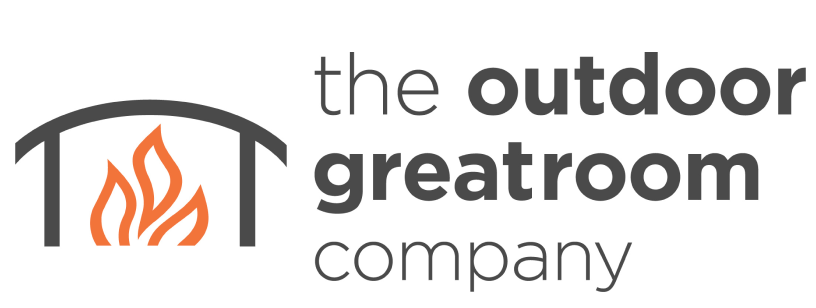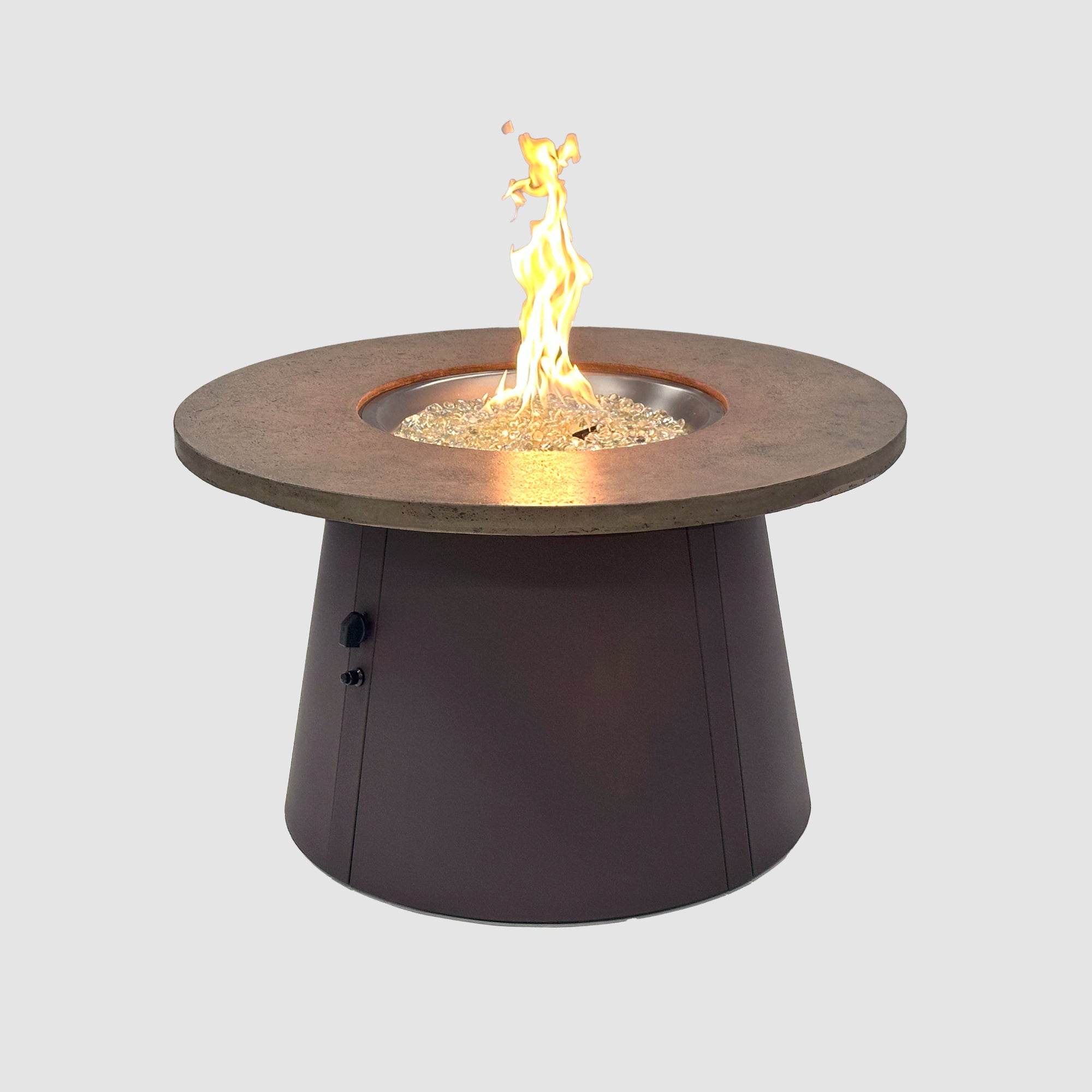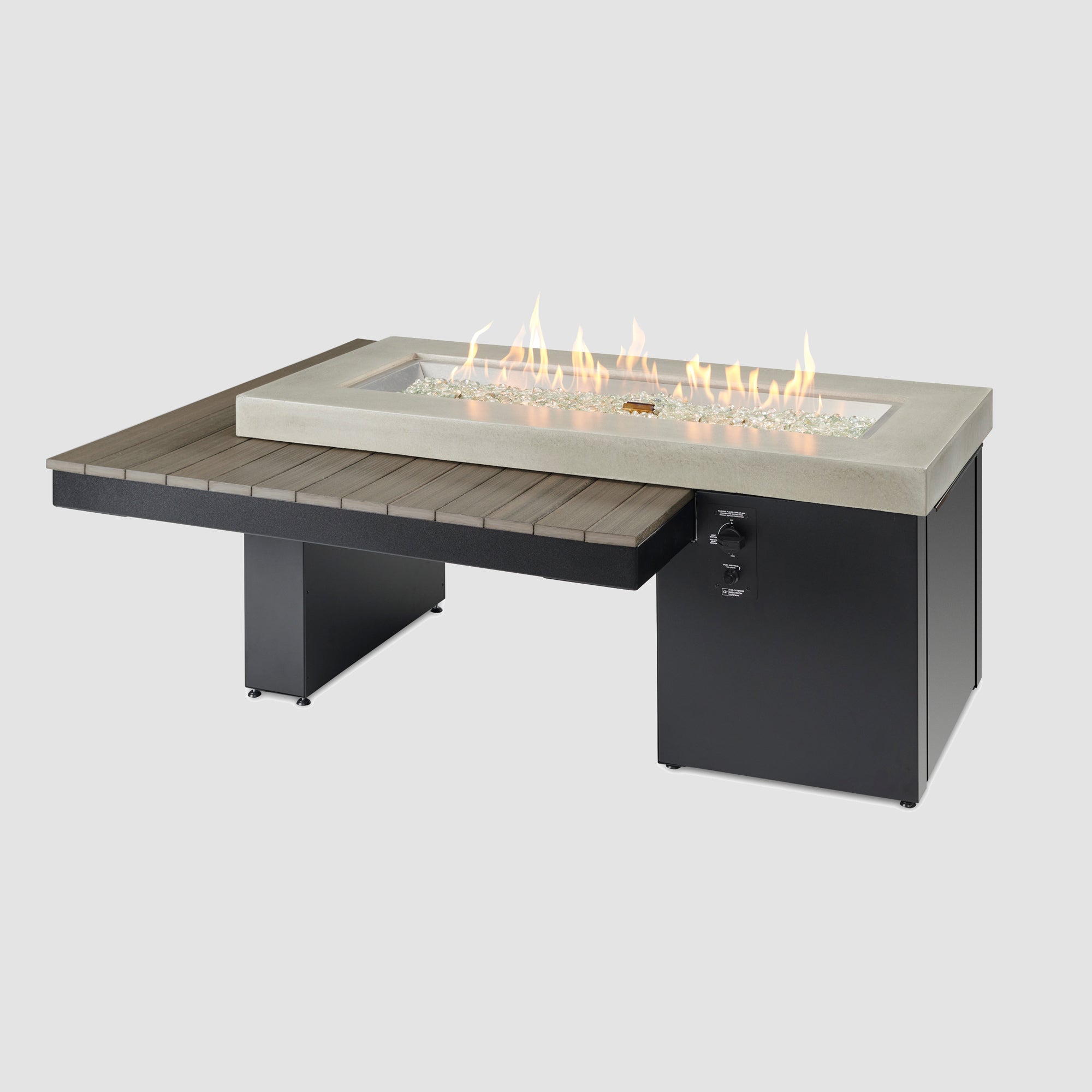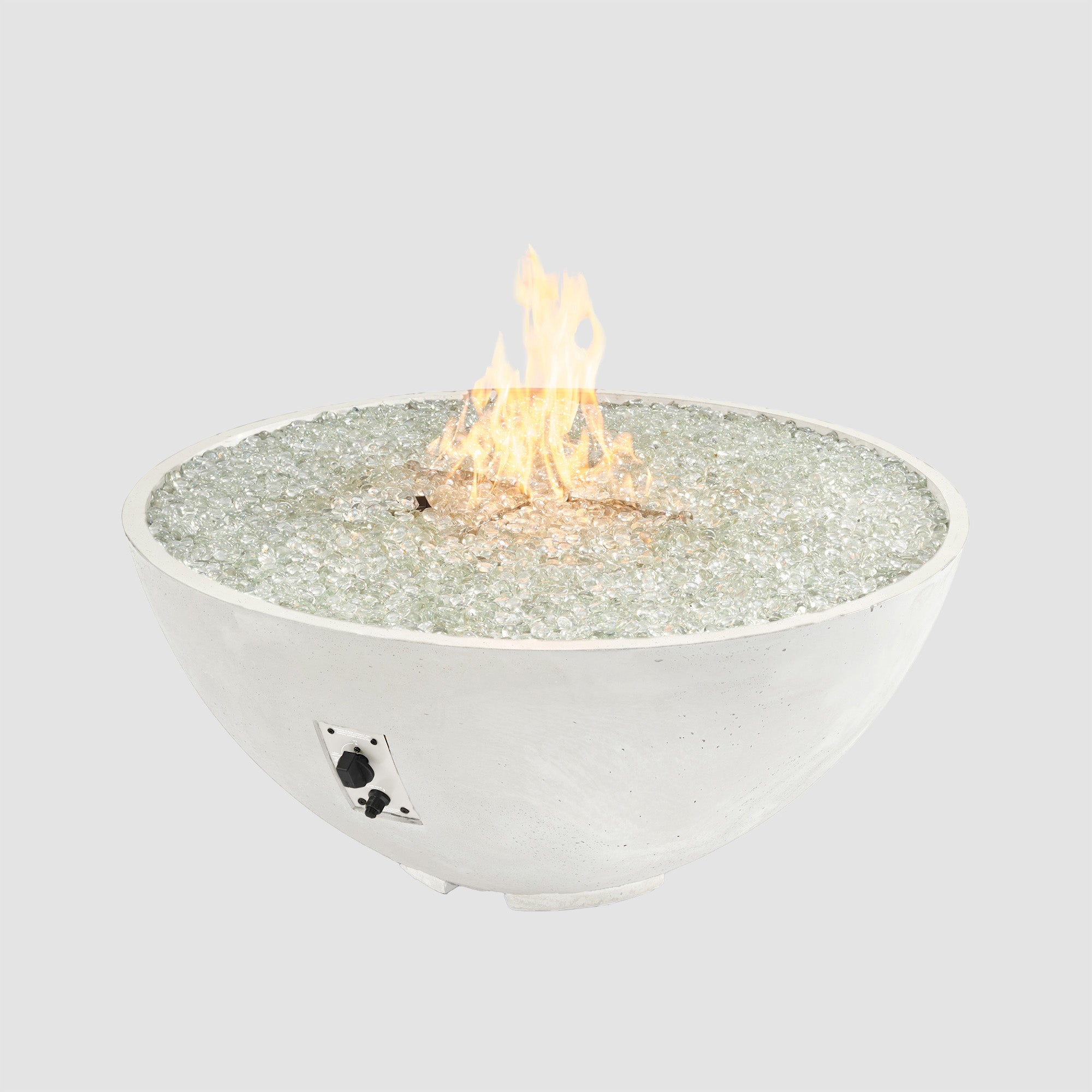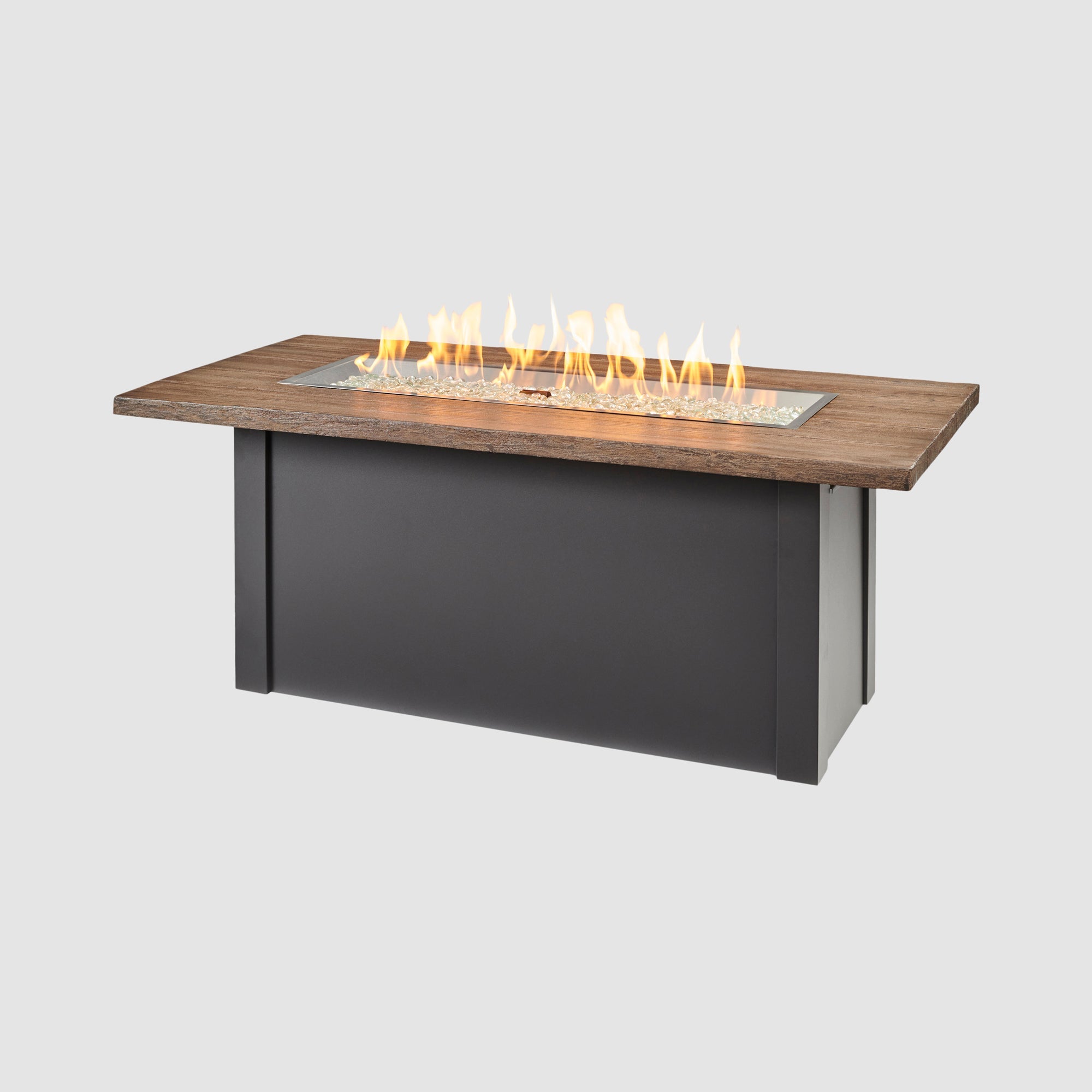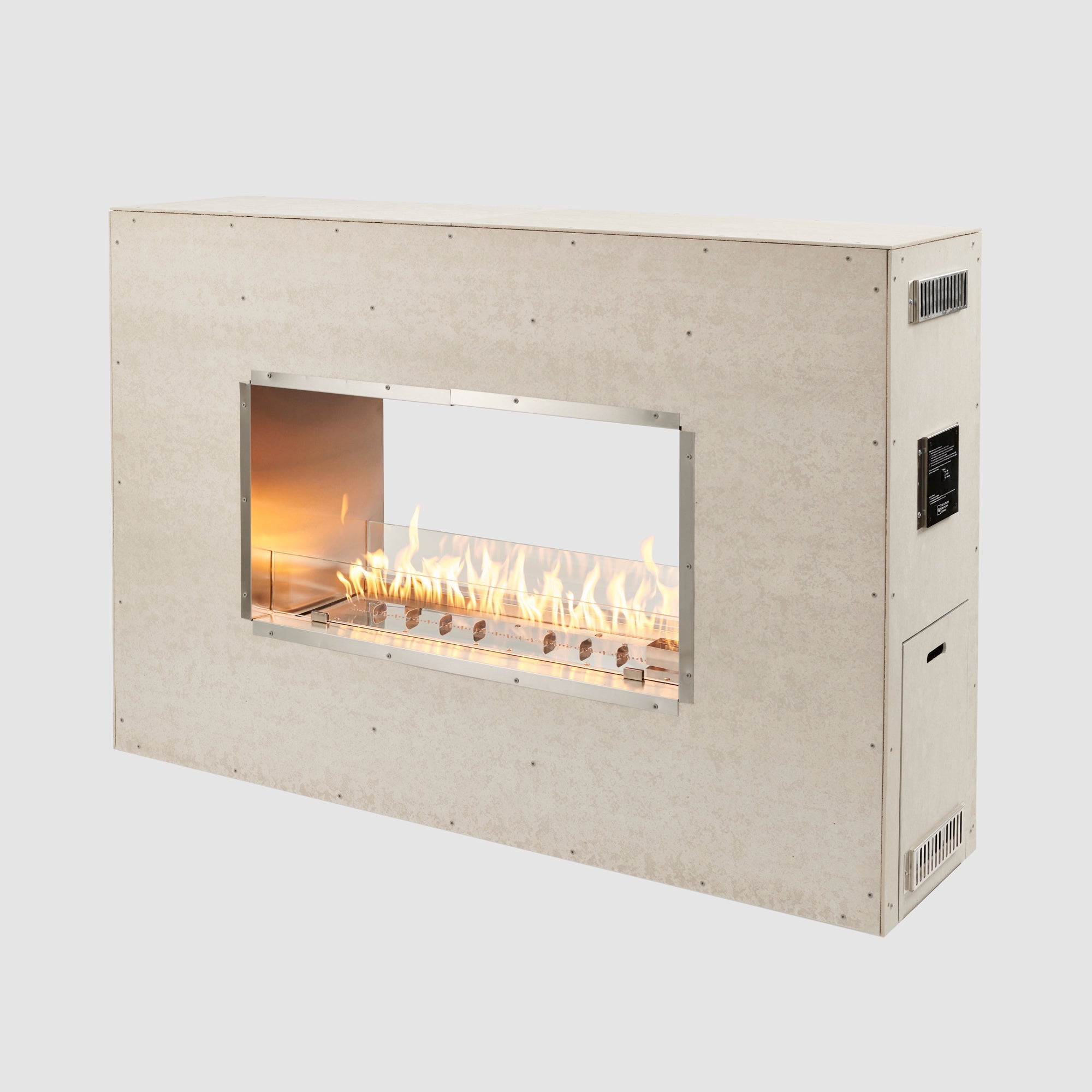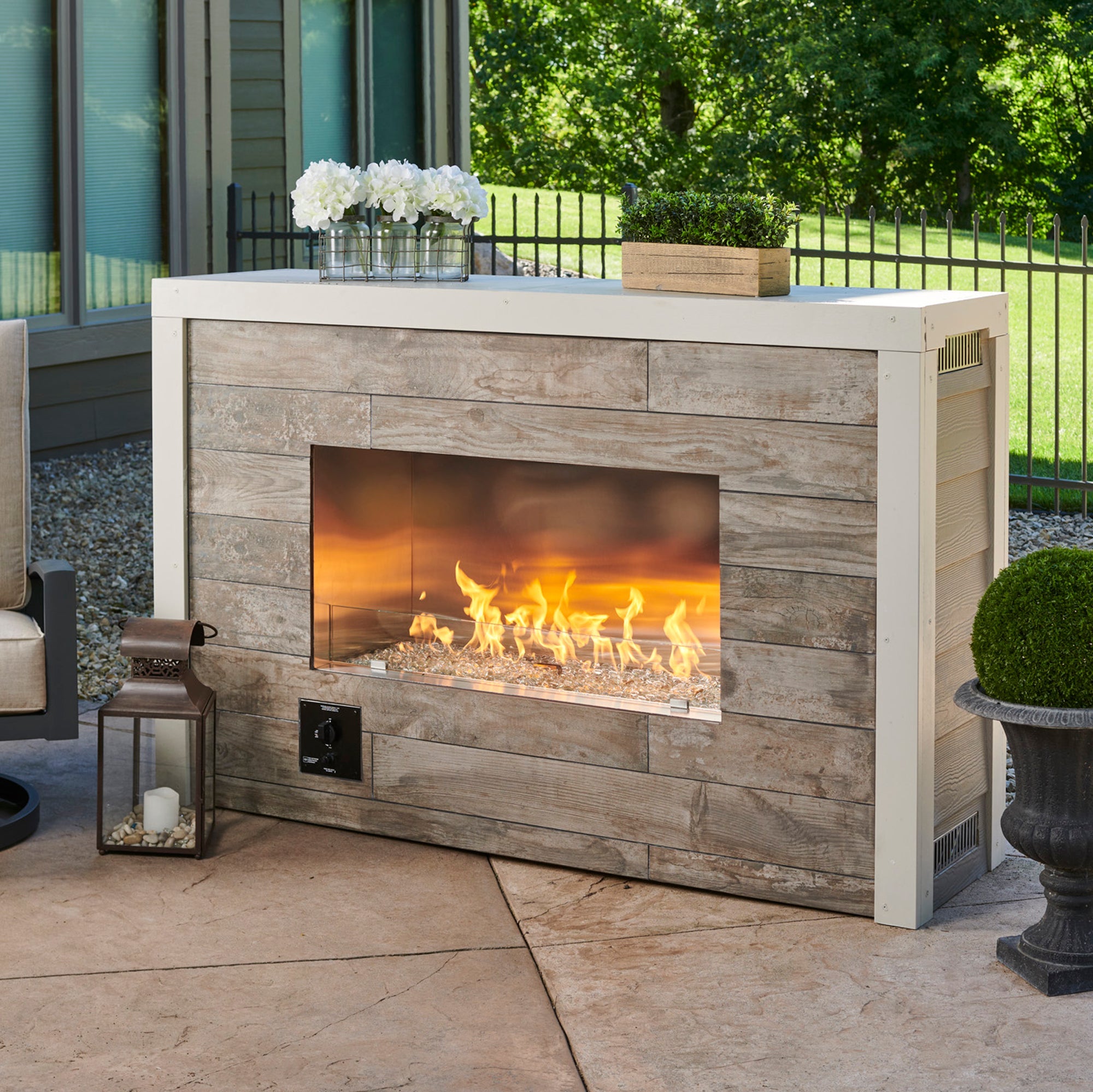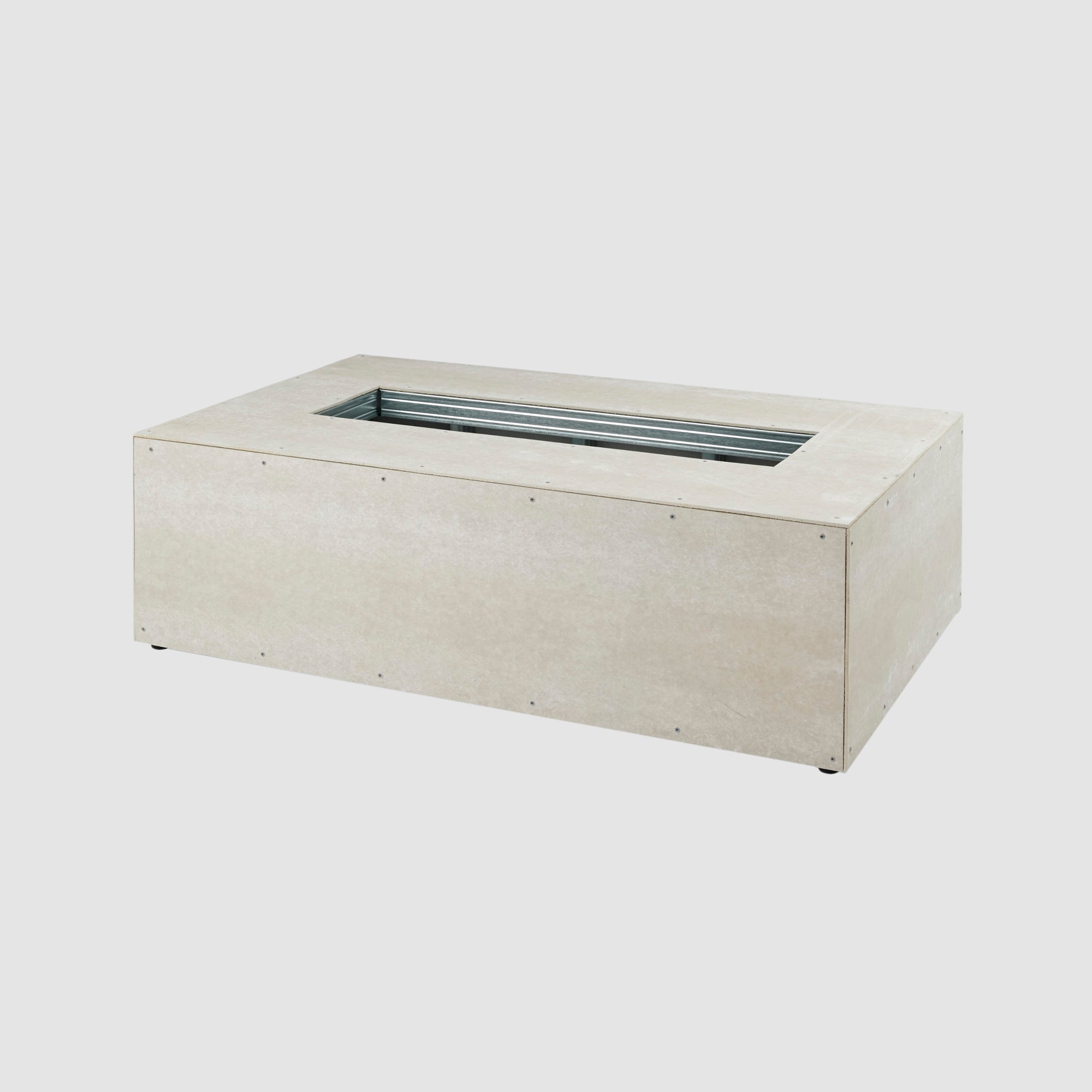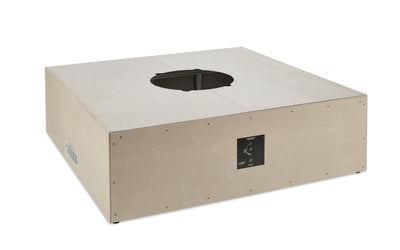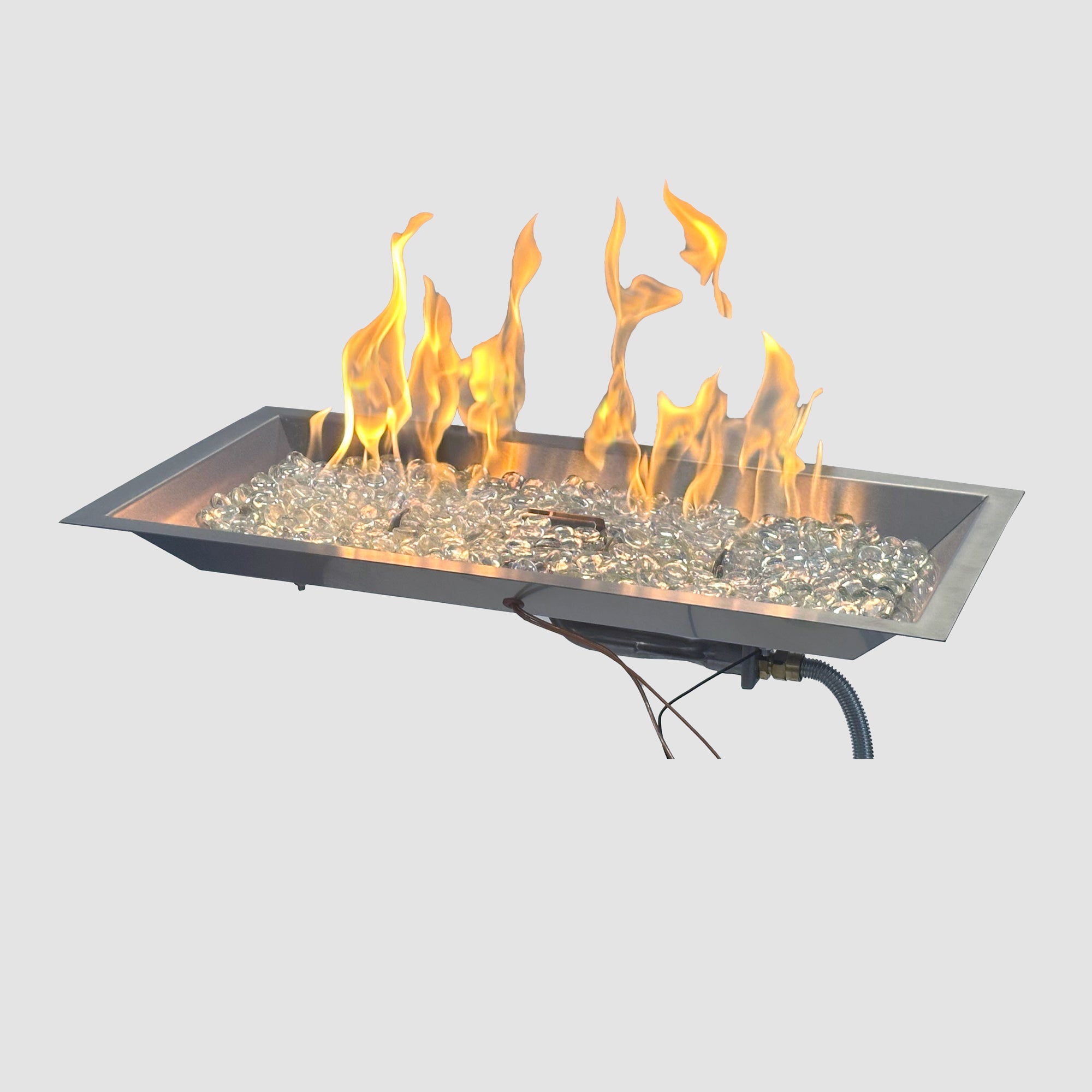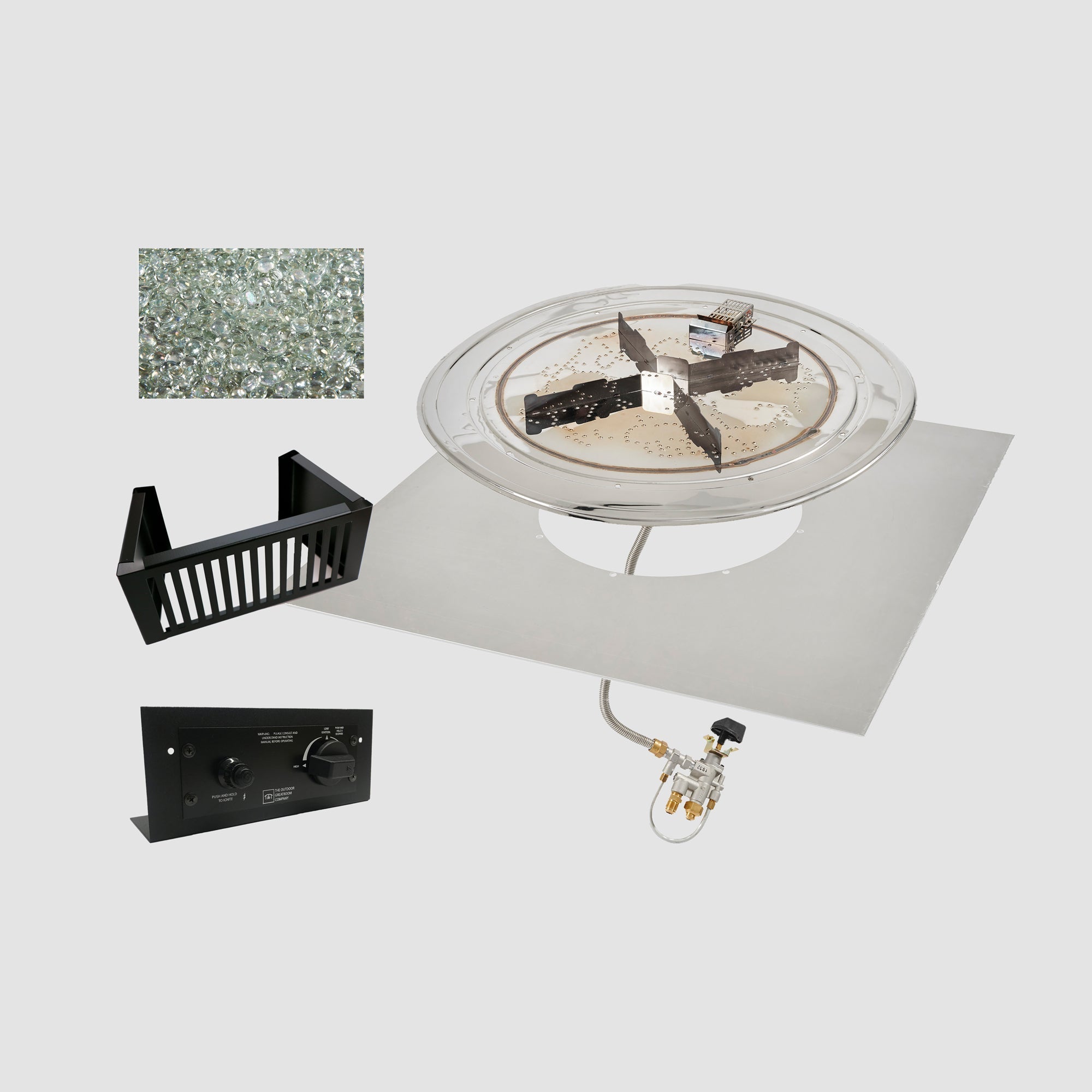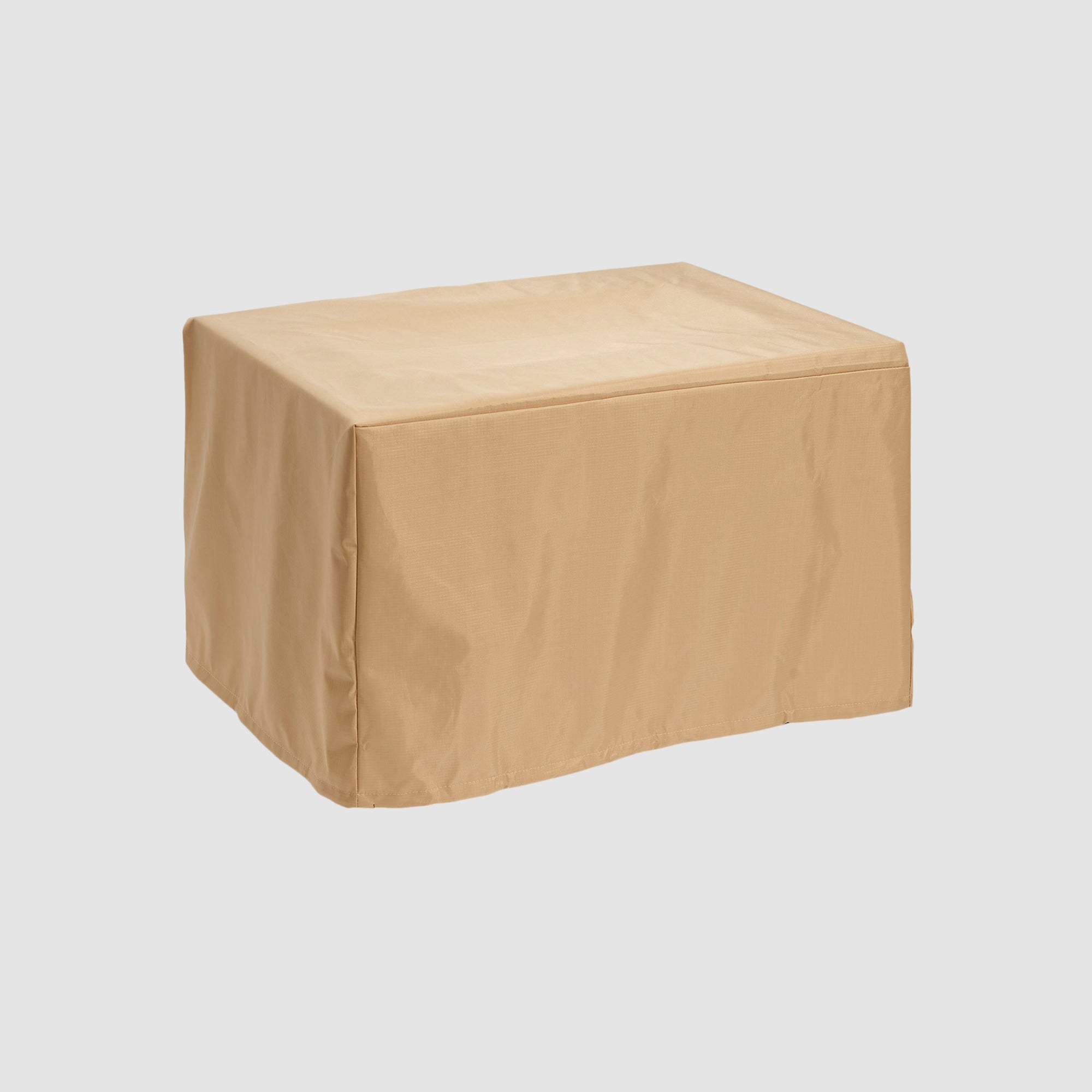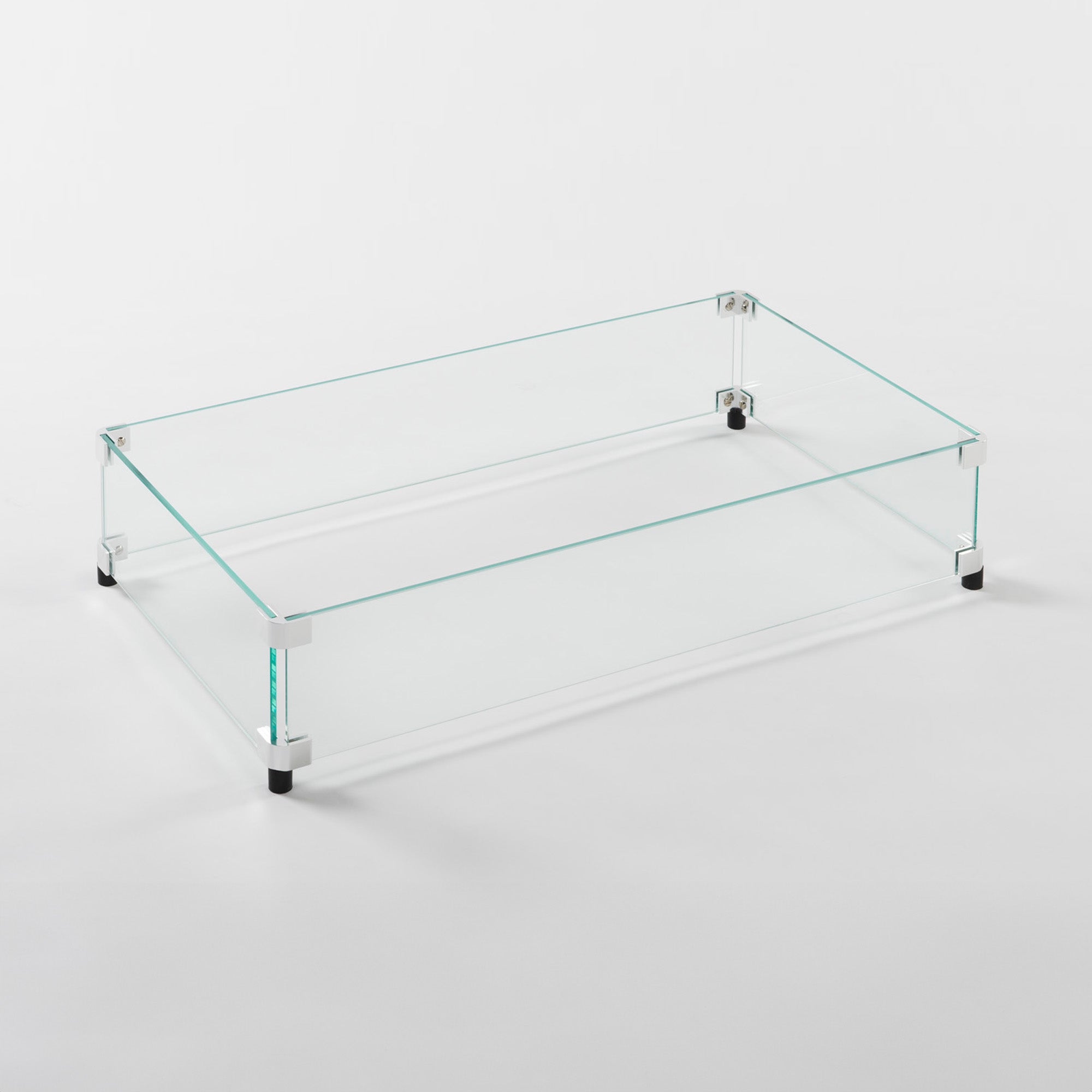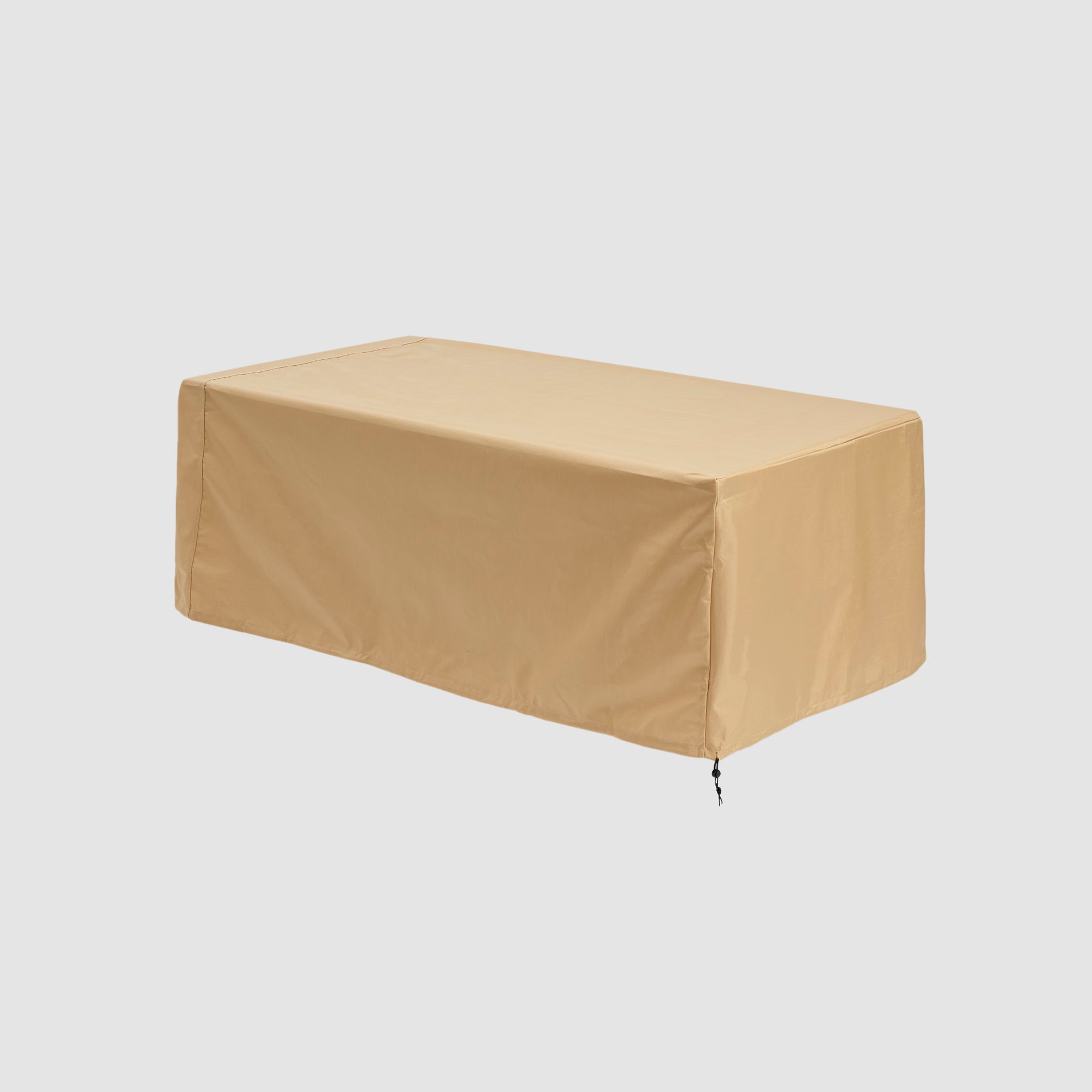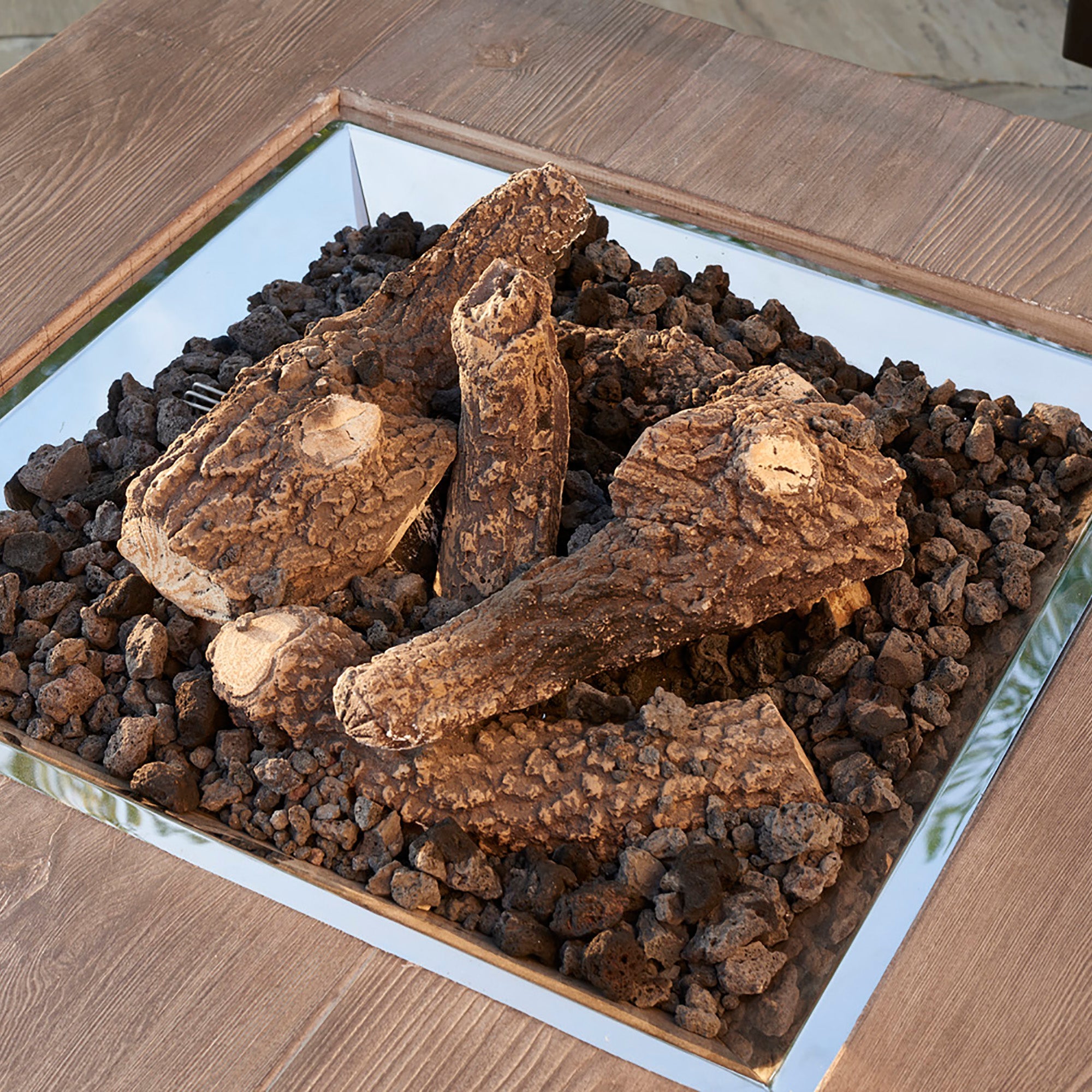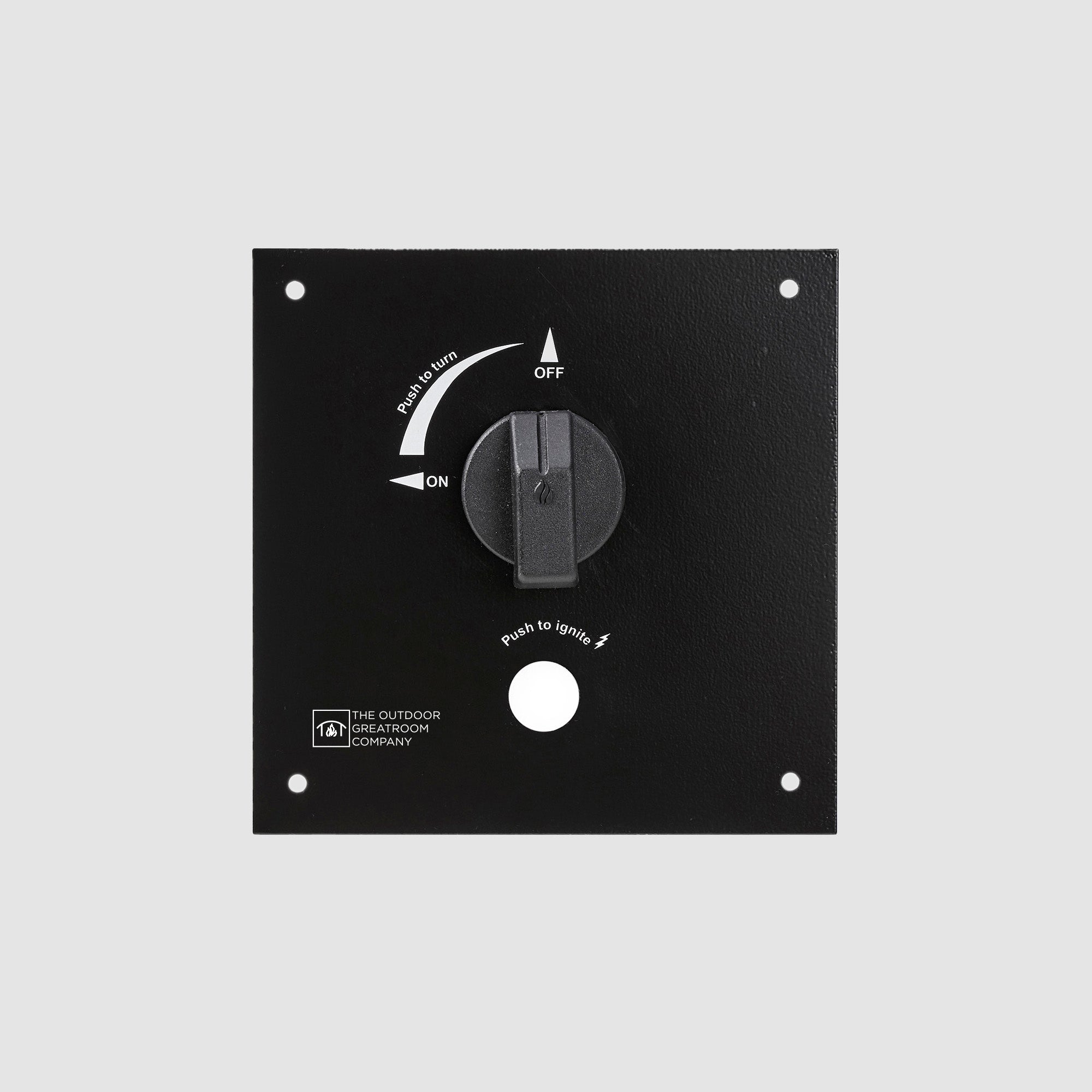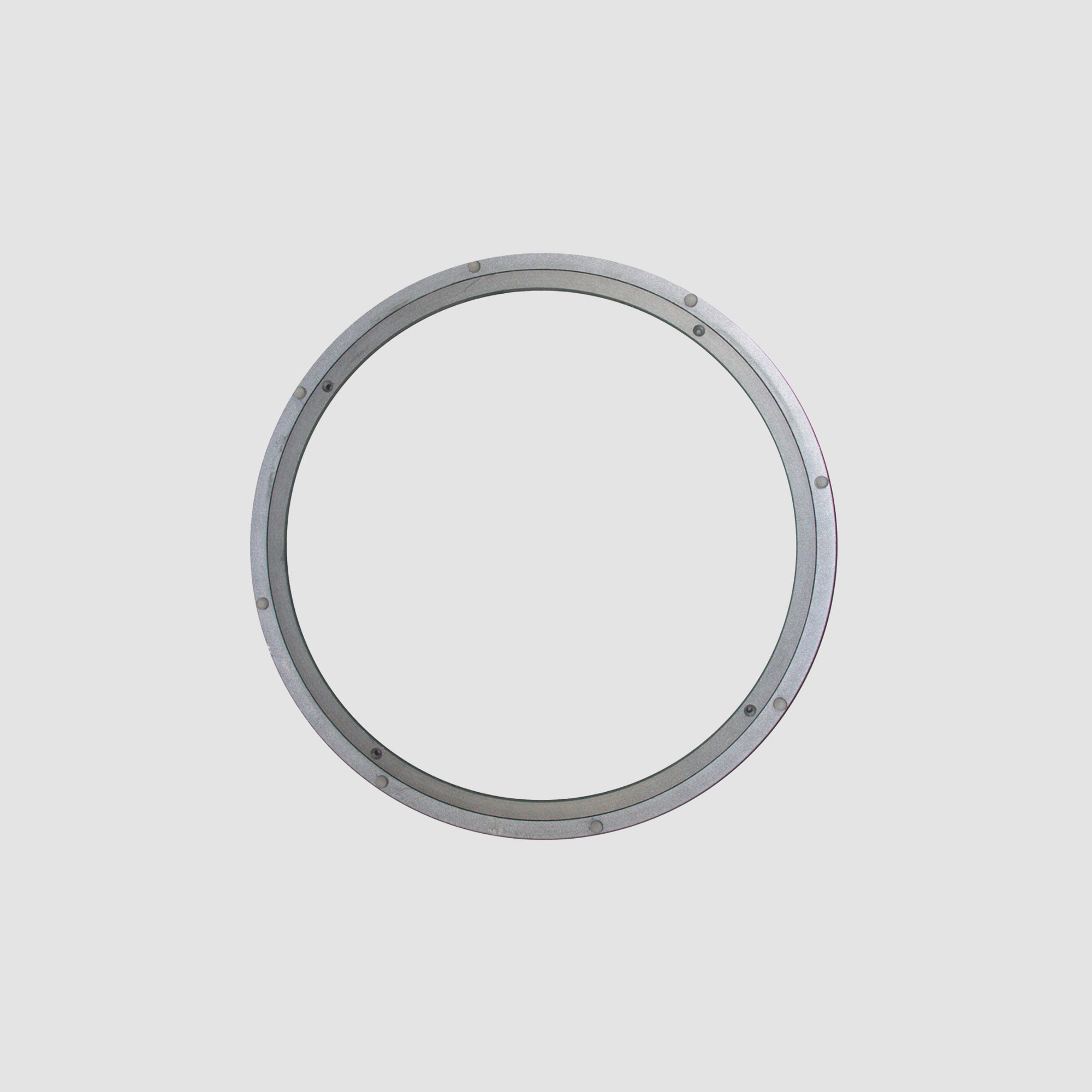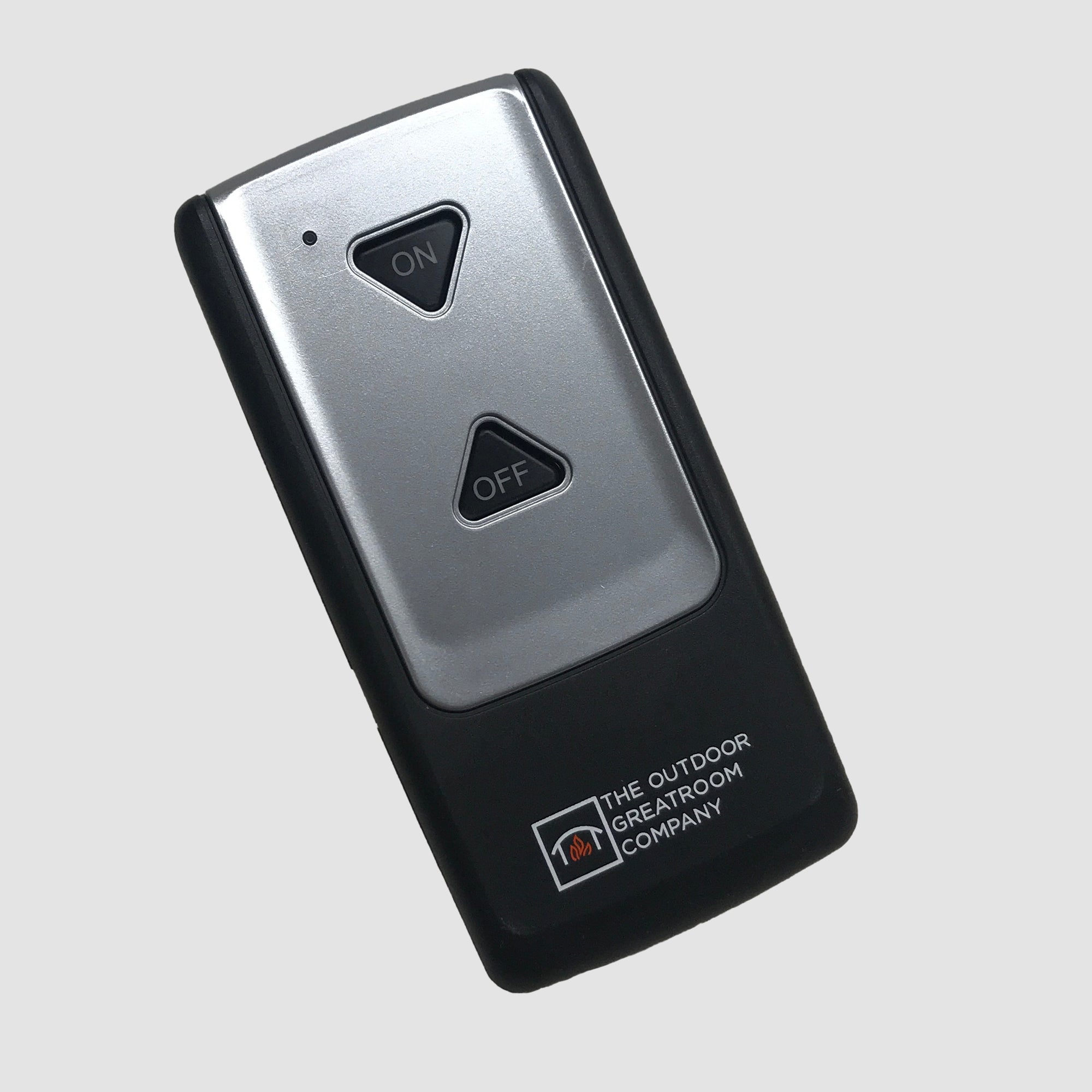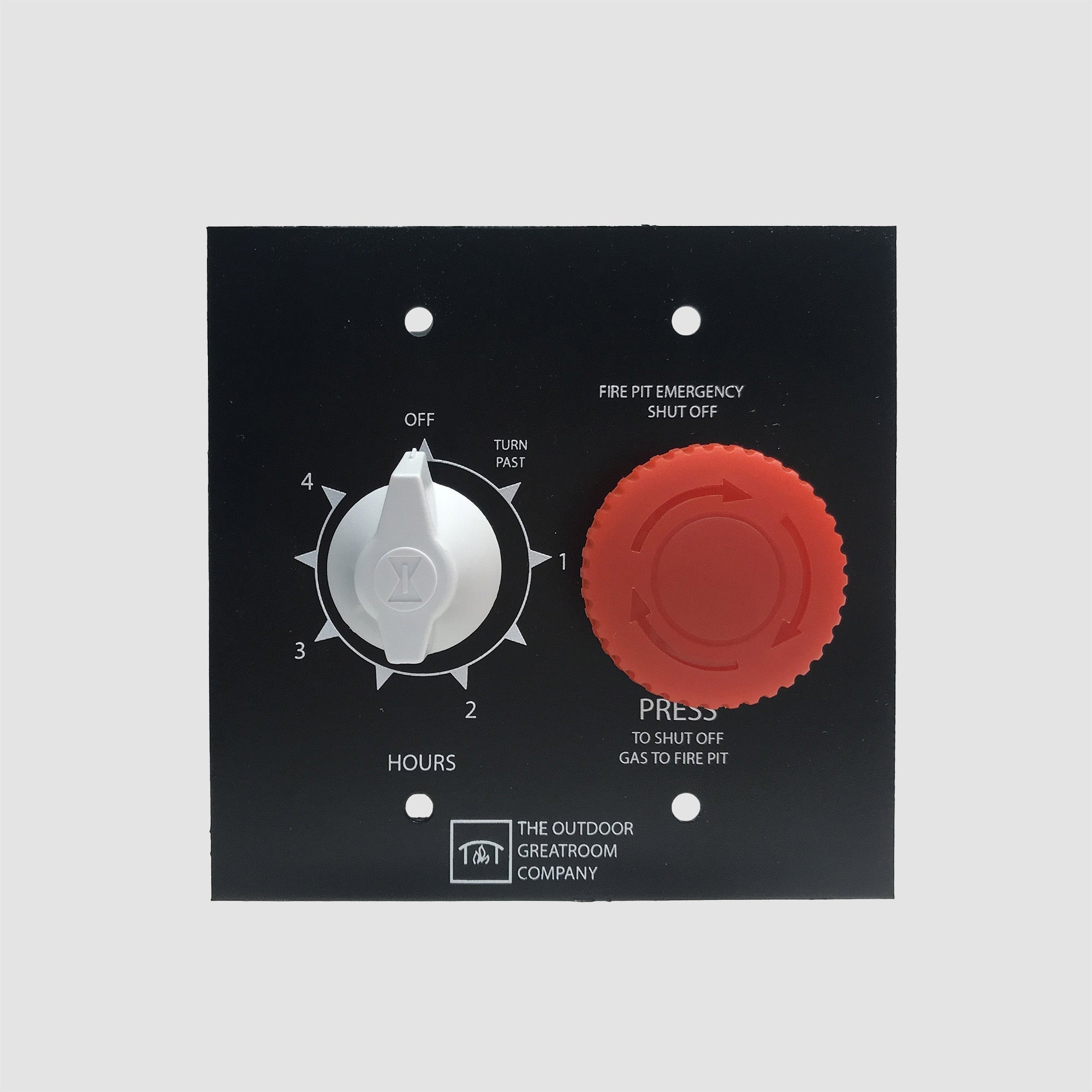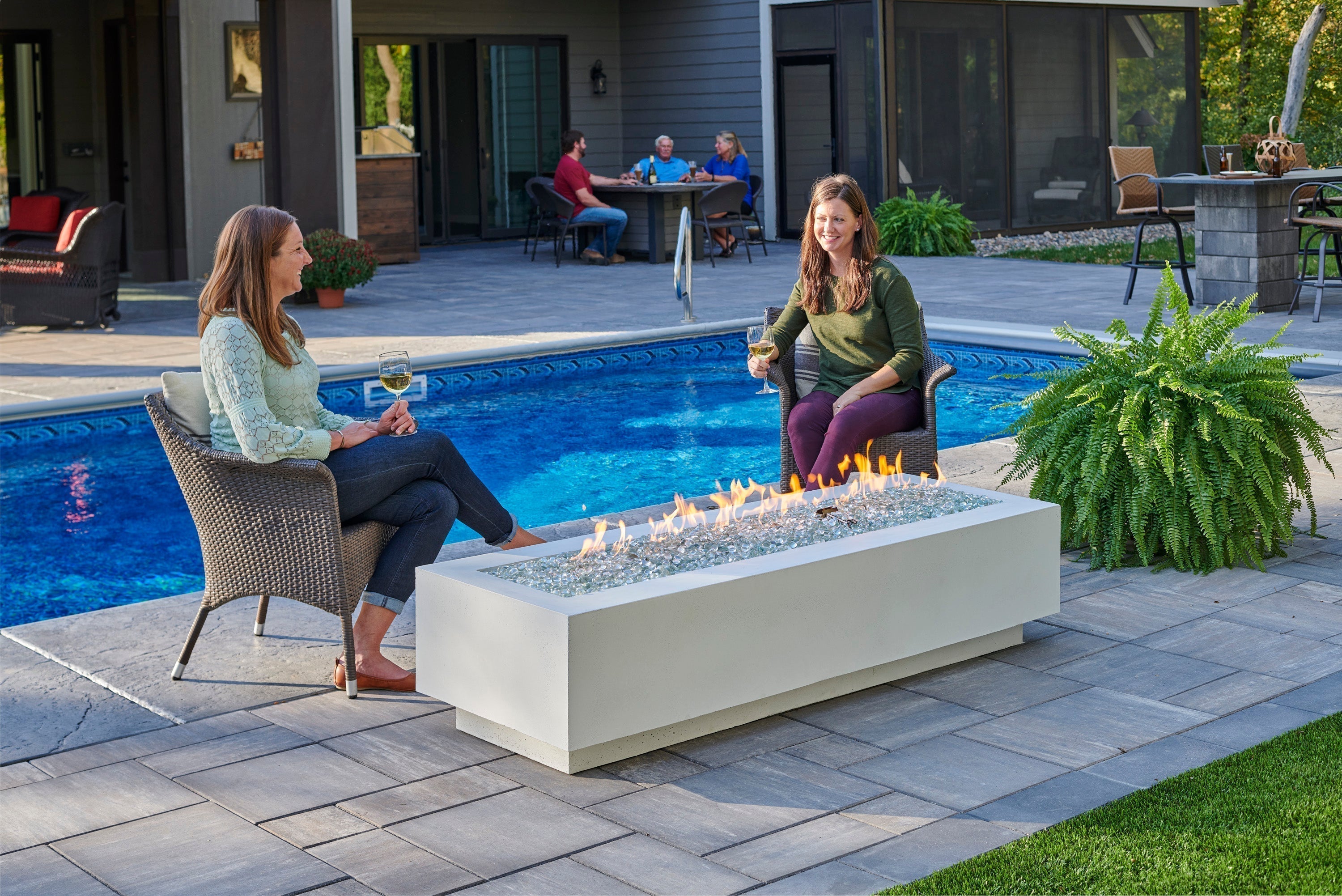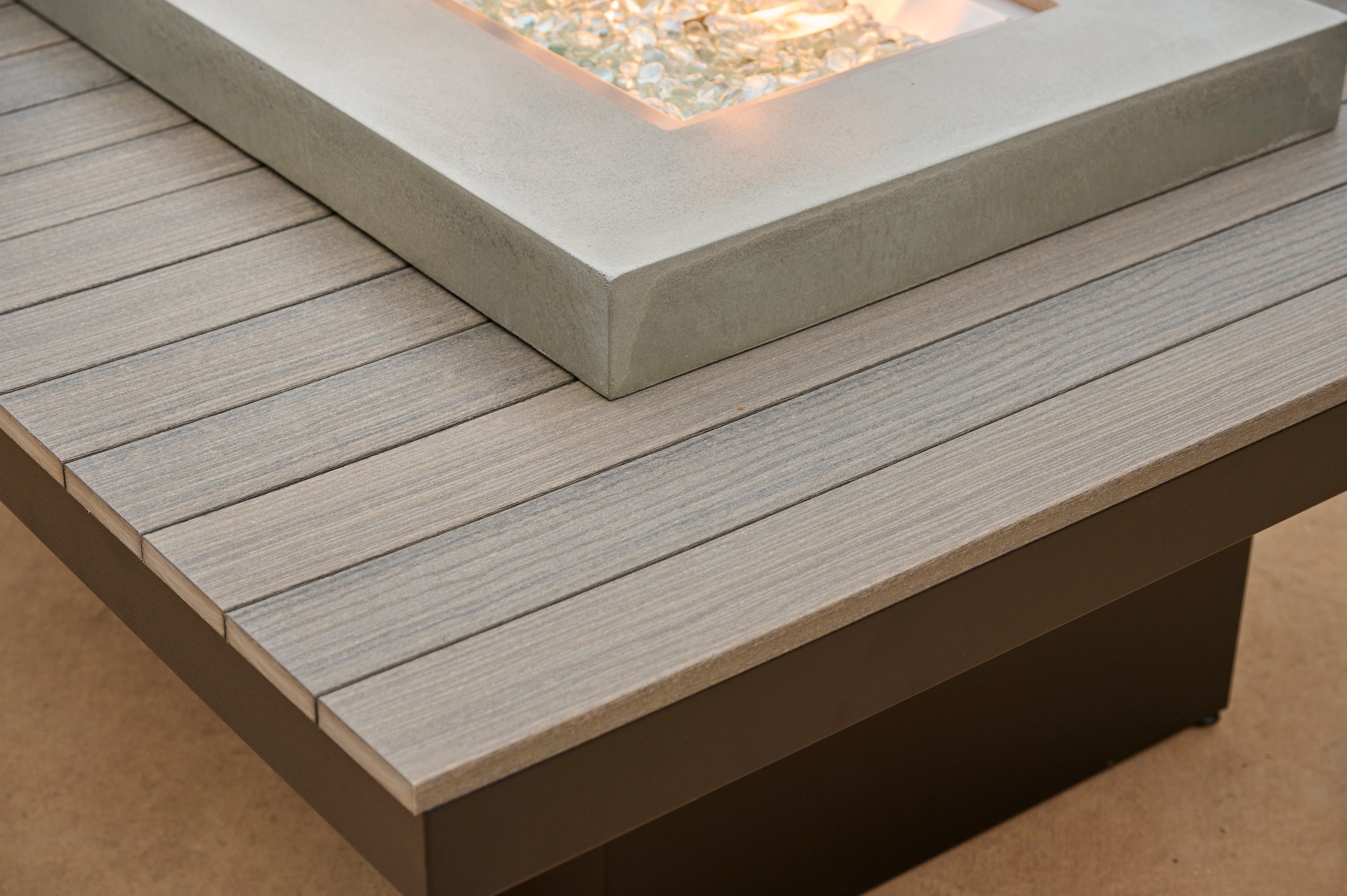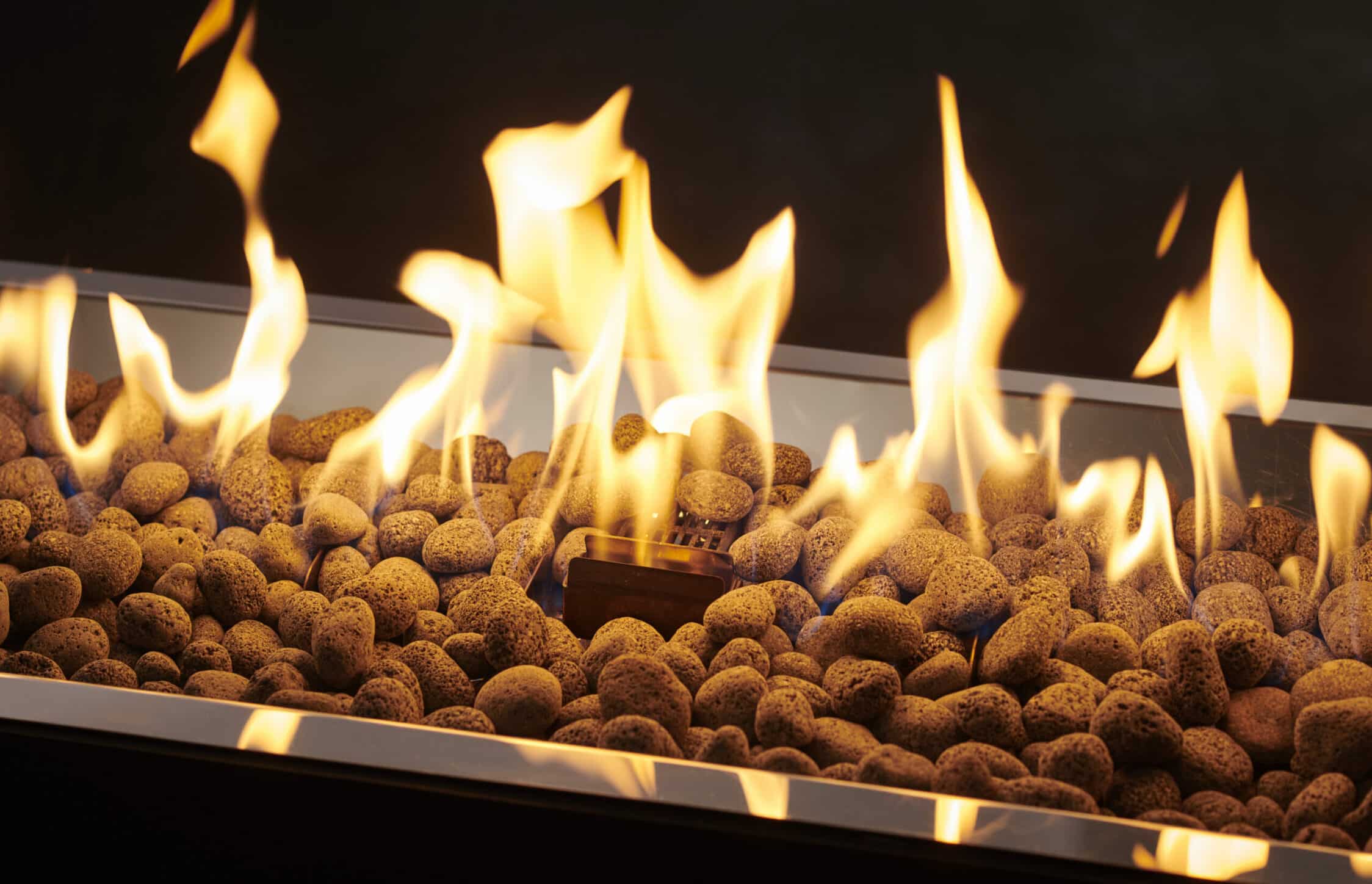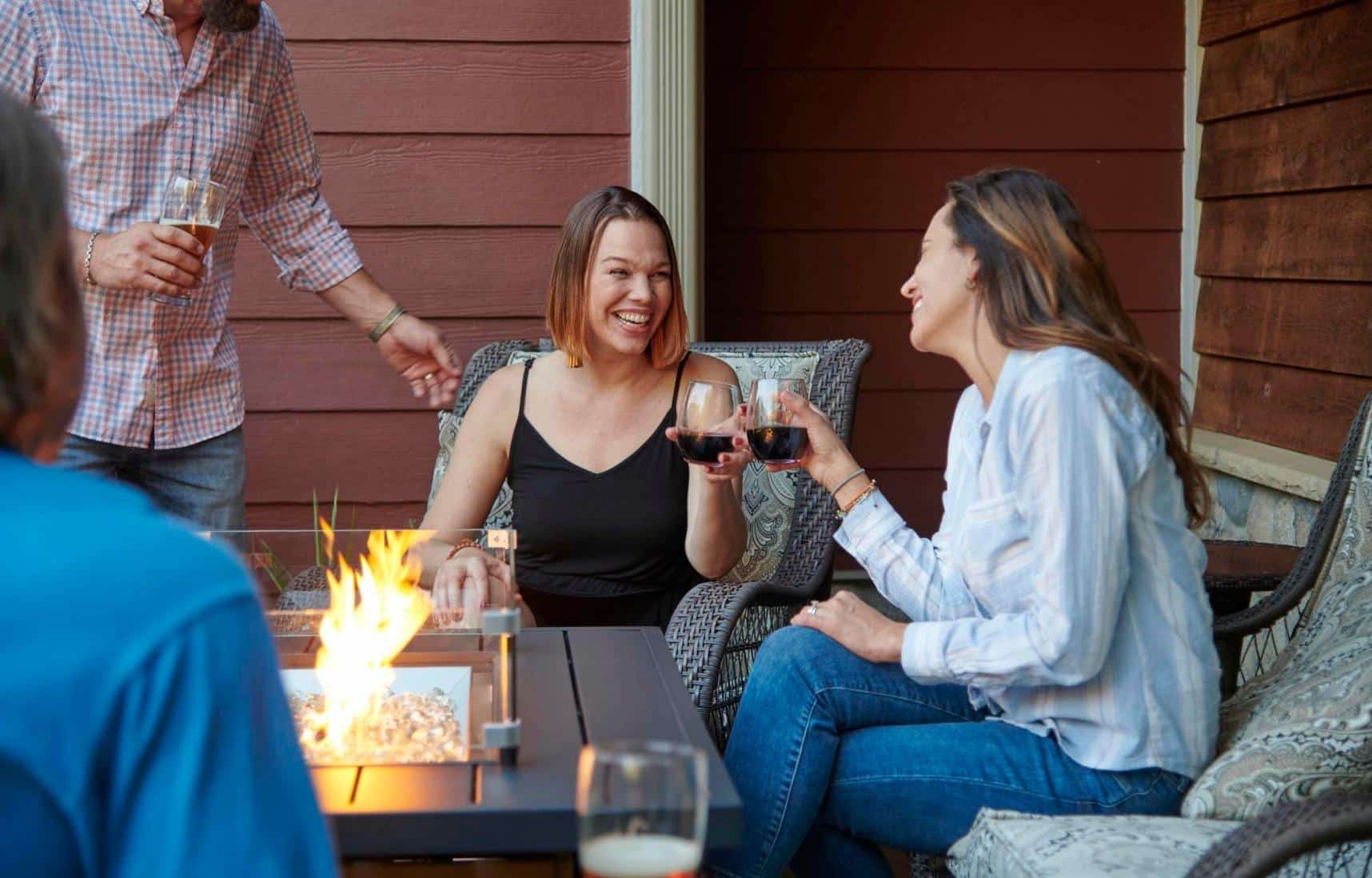FAQs
Fire Pit Tables FAQs
Why is there pitting in Supercast™?
Why is there pitting in Supercast™?
As a result of the casting procedure, air becomes entrapped within the Supercast™ mix and on the surface of the molding material. Supercast™ uses a high cement to water mix ratio; this creates a very thick, dense composition making it difficult for trapped air to escape. Thorough processes are incorporated into the casting process in order to minimize the number of pits visible on a finished Supercast™ piece. Plasticizer additives are used in the Supercast™ composition in order to create a more fluid mixture without increasing the percentage of water, as water decreases the strength of the composition. Agitation of the piece is also performed during the process to allow trapped air to escape. While the composition and casting process is designed to allow air bubbles to escape, surface tension on the surfaces of the piece prevent a small percentage of smaller air pockets from releasing. The pitting is an inherent component of casting Supercast™. The presence of pitting does not compromise the durability or strength of the piece but adds to the distinctive look.
Why is my sliding tank door not sliding smoothly?
Why is my sliding tank door not sliding smoothly?
Similar to other moving parts used outside, we recommend lubricating the slides at least once a year and as needed. Lubricating the slides will help them operate smoothly and extend their life. Any spray lubricant, such as WD-40, can be used to spray into the bearings of the drawer. After lubricating both slides, slide the drawer back and forth a few times to spread the lubrication. WARNING! Do not spray lubricant while burner is operating. Disconnect and remove the propane tank from the base before spraying lubrication. View the sliding tank door bulletin for assistance.
Where can I use my OGC Fire Pit Table?
Where can I use my OGC Fire Pit Table?
Q1: Can I use my fire pit table indoors or in an enclosed space?
A: No, this fire pit table is designed for outdoor use only. It must be installed in a well-ventilated outdoor space. Enclosed structures or fully covered areas that restrict airflow are not safe and not compliant with the installation requirements.
Q2: What are the minimum clearance distances I need to maintain around my fire pit table?
A: To ensure safety and prevent fire hazards:
- Keep at least 24 inches (2 feet) clearance from the edge of the burner to any combustible side walls or materials.
- Maintain a clearance of 72 inches (6 feet) above the top of the burner to any overhead combustible materials (like roofs or awnings).
- For specific fire pit models, minimum clearances to combustible materials are generally 4 inches on all sides for CFP models. Some BI models require larger clearances (up to 7 inches on certain sides). Be sure to check your specific model's requirements.
Q3: Can my fire pit table be placed under a pergola or partial cover?
A: It can be placed in a partial enclosure if it meets these criteria:
- Two side walls with an overhead cover (walls can be parallel or at right angles), or
- Three side walls with an overhead cover, but with at least 30% of the surrounding side wall area permanently open to ensure ventilation.
If the space is fully enclosed or has four walls with a roof and no openings, it does not qualify as an outdoor space for safe installation.
Q4: Are there any recommendations for the surface or location to place the fire pit table?
A: Yes, install the table on a solid, level surface to ensure stability and proper operation. Also, ensure:
- Easy access to the appliance control panel and gas connections for service
- Walkways around the appliance are not restricted by the installation setup
What type of fuels can I use?
What type of fuels can I use?
You can choose from either LP (liquid propane) or NG (natural gas.) The Crystal Fire® Plus Burner unit comes set-up for LP, unless otherwise noted, and can be converted to NG with a NG conversion kit that comes with the unit.
What makes a concrete top unique?
What makes a concrete top unique?
Your top is handcrafted from Portland cement concrete and reinforced with glass fibers to provide exceptional strength and durability compared to traditional concrete. Supercast™ is typically 1/3 of the thickness of traditional concrete with 3 times the strength. Each piece offers its own uniqueness; you may notice color variations in your fire table top or outdoor kitchen countertop. This is intentionally done during the molding process in order to create a unique natural appearance which mimics natural stone. One factor that may slightly affect coloration is thickness. On fire pit table tops, the burner cover may appear slightly different than the rest of the top due to the difference in thickness. Due to the physical properties of concrete, small hairline cracks may appear in the surface over time. This is normal and does not affect structural integrity of the top. If cracking is severe or deep, repair or replacement may be required. A minimum of two coats of solvent-based acrylic sealer are applied during the manufacturing process. Because of varying porosity in concrete sealer, it may be absorbed differently throughout the top. Due to this you may notice varying luster.
What is the recommended seasonal maintenance for fire pit tables?
What is the recommended seasonal maintenance for fire pit tables?
The following information describes installation, general care and maintenance for OGC fire pits when putting away for winter and setting up in the spring. Your fire pit is built to last and by caring for it correctly, you will enjoy it for years. Spring Checklist • Remove protective cover • Remove burner cover • Remove glass gems from burner. The burner can be cleaned by removing all of the glass gems and wiping down the edges and surface of the burner. A wet cloth/paper towel can be used to clean off any dirt. The glass gems can also be cleaned with a wet cloth/paper towel. These can be cleaned as needed depending on the amount of dirt and debris that land in the burner. Clean burner using damp cloth checking burner for any clogged port holes. Port holes can be unclogged using a toothpick or something similar. Put glass gems into burner. • Remove Crystal Fire® Burner from fire pit top. Untighten the metal flex hose to orifice connection. • Unscrew orifice from burner to check and see if there is any debris/frozen water/etc in the neck of the burner. Use a pliers or finger to remove any excess debris. An air hose may be needed to clean out this burner neck as a last resort. All blockages should be removed before next step. • Screw in orifice and tighten with metal flex hose using two wrenches. • Check other gas connections to make sure they are tight. If tightening is needed, make sure to use two wrenches. • Check the sparker connections from the burner to the sparker box. Make sure they are plugged in and the AAA battery works. Check electrode in burner for blue spark, should be spaced at 3/16” apart. • Make sure gas valve on base is in off position and hook up LP tank, open up valve on LP tank or turn on NG gas valve. • Push in sparker button and slowly open gas valve. • Check flame for any irregularities or any smell of gas. If gas is smelled shut off immediately and check gas connections. • Clean off fire pit top and base with damp cloth. If top is stainless, stainless steel cleaner is recommended. If top is supercast, resealing with concrete sealer may be needed. • Tighten screws on glass guard clips and set on fire pit top. Clean glass guard with windex and paper towel. Winter Checklist • Remove any debris (leaves, dirt) from the burner • Close gas valve on fire pit base or shut off gas for NG. • Shut off and remove LP tank from base • Remove glass guard and store • Cover Crystal Fire® Burner with OGC burner cover • Wipe down fire pit top and burner • Removing glass gems from burner to clean – optional – can be done in winter or spring • Cover fire pit table with OGC protective cover
What is Supercast™?
What is Supercast™?
Supercast™ is a proprietary blend of fiber glass and polymer fortified concrete. We offer a variety of colors and finishes.
How do I maintain the Supercast™ finish?
How do I maintain the Supercast™ finish?
Keep the top clean do not allow dust, dirt, water to stand on the top. Your top is very similar to your kitchen counter except for outdoor use. Use a mild mixture of dish detergent and warm water. • Do not put the cover on when the table is wet. • Cover the unit to protect from buildup of water, snow, dust, dirt, and debris. • Ensure the top is dry prior to covering for an extended period.
What is The Outdoor GreatRoom Company's Everblend Material?
What is The Outdoor GreatRoom Company's Everblend Material?
How do you maintain Everblend tops?
How do you maintain Everblend tops?
What happens to my fire pit when it rains?
What happens to my fire pit when it rains?
Crystal Fire Plus burners and burner inserts feature raised, extruded ports and a slightly pitched design. This unique burner design causes water to drain to the perimeter, away from the burner. The water then drains to the bottom of the fire pit enclosure.
- Safety precaution: Avoid using the fire pit during rainy conditions to minimize the risk of damage and ensure safe operation.
- Protection: When your fire pit is not in use or if rain is expected, cover the appliance with a waterproof cover designed for your fire pit model. This helps keep the burner and glass media dry and protected.
Is the fire pit or fireplace approved for use in screened porches, gazebos, and lanais?
Is the fire pit or fireplace approved for use in screened porches, gazebos, and lanais?
The unit itself is not UL approved for this application, but there should not be any problem provided the following guidelines are followed: A minimum of three walls are screened. Screens must be permanently open. They cannot have windows that can close. The screened walls must provide a minimum open area of 30%. All appliance ceiling and wall clearances must be met. Minimum porch area 96 square feet.
Is media included with the Crystal Fire® Plus Burner or Fire Pit Table?
Is media included with the Crystal Fire® Plus Burner or Fire Pit Table?
Yes, we include Clear Tempered Fire Glass Gems with each Crystal Fire® Plus Burner (some exceptions apply.) The glass used is a heat-tempered, tumbled glass gem.
Is a propane tank included?
Is a propane tank included?
Propane tanks are not included with any purchase. A 20 lb. LP tank can be purchased typically from hardware stores and gas stations.
How long will a 20 lb. LP tank last in my fire pit table?
How long will a 20 lb. LP tank last in my fire pit table?
There are two factors that ultimately dictate how long your LP tank will last. The first factor is the ambient conditions when you are operating your burner. The humidity and temperature will have an influence on how long the LP tank will last. As the ambient temperature drops, it becomes more difficult for the LP tank to keep up with the demand for fuel going to the burner. This is because the process that converts liquid propane to usable propane vapor slows down as temperature decreases. Similarly, as ambient humidity drops that same process slows down because the tank is less able to insulate itself with condensation as it converts liquid propane to propane vapor. Flame height setting is the other factor that affects how long an LP tank will last. When the control valve is set to “High” the burner will use more fuel than when the same burner is set to operate on “Low”. See chart that outlines the estimated burn time of a 20 lb. tank when considering flame setting.
How do I replace my sliding tank door slides?
How do I replace my sliding tank door slides?
After contacting OGC and determining the slide is broken and beyond repair, a set of replacement slides is needed. 1. Once the original door has been removed (see FAQ: How do I re-attach my sliding tank door for assistance), remove the mounts from the door/tank tray assembly. 2. Remove 4 screws and nuts holding the mounts in place, save for replacement of new slides in step 6. 3. Remove the slides from the inside frame of the fire pit by removing the sheet metal screws holding them in place. NOTE: the alignment of the slide is critical, it may be useful to replace one slide at a time so you can reference the screw placement from the other side. 4. Remove the mount from the new slide by pressing on the lever and pulling apart to separate the mount and the slide. Repeat for other slide. 5. Attach the slides to the frame of the table with sheet metal screws, use the same hole locations as the old slide. If the holes in the base are stripped, it may be necessary to drill them out using a 3/16” drill bit, and assemble with a #8-32 Screw and nut. 6. Assemble the new mounts onto the tank tray, using the nuts and bolts you previously removed. Finally replace door into base, following instructions in FAQ: How do I re-attach my sliding tank door? View the sliding tank door bulletin for assistance.
How do I re-attach my sliding tank door?
How do I re-attach my sliding tank door?
1. Remove the door from the slide, press up or down (depending on the side) on the plastic clip, and carefully pull the door off of the track. 2. Check to make sure the plastic clips on both of the slides are not damaged, and that no ball bearings have fallen out of the slides. If the slides are damaged, it may be necessary to replace them. 3. Align the mounts on the tank tray with the slides mounted to the interior of the base. Two people may be required for this step, one to hold the door/tank tray assembly and one to guide the mounts into the sliders. 4. Insert the mounts into the slides. Keep outward pressure on the slide mounts as you push them into the slides to keep them properly aligned. Push until you hear a click on each side of the slide. The first time you insert the drawer, it may require a bit of force to fully close the door, after this the drawer should slide in and out with ease. Contact OGC for further troubleshooting. View the sliding tank door bulletin for assistance.
How do I properly size my fire pit table gas supply line?
How do I properly size my fire pit table gas supply line?
We recommend you contact a NFI certified gas technician to help with properly sizing your gas supply line.
How do I maintain the Vintage Fire Pit Table wood base?
How do I maintain the Vintage Fire Pit Table wood base?
The Vintage Fire Pit Table features a cedar wood base that is intentionally left unsealed to age naturally. If left unsealed, the wood will become grayer as time continues. If you would like to stop the natural aging of the wood or if you would like to seal in the “vintage” finish, the base can be sealed with a wood sealer. To maintain the appearance of the finished base, a new coat of sealer will need to be reapplied every few years. Before sealing, clean with a pressure washer or deck washer but be careful to not damage the surrounding framework, tile, or other finishes. It is not necessary to seal the wood and the final finish is left up to your preference.
How can I touch up my Supercast™ stain?
How can I touch up my Supercast™ stain?
Instructions for staining Supercast™ 1. Clean affected area before attempting to stain. Make sure area is clear of dirt, dust or debris. 2. Use dropper to apply generous amount of stain to exposed Supercast™ material. Only apply stain to exposed Supercast™, stain will not penetrate Supercast™ sealer. 3. Allow stain to soak into the Supercast™ for 30 seconds to 1 minute and use a clean rag to wipe off excess stain. 4. Repeat steps 2 & 3 until desired stain color and darkness is achieved. 5. For larger areas it is recommended to seal the re-stained area with an acrylic based sealer to protect it from the elements. SC-SEALER is available through The Outdoor GreatRoom Company.
How can I return my Supercast™ top to its original appearance?
How can I return my Supercast™ top to its original appearance?
• First clean using a diluted solution of vinegar and water to remove any dirt or debris that may have accumulated on the surface. • If the top remains dull, reseal your top with SC-SEALER from The Outdoor GreatRoom Company. • After cleaning all dust and debris from the top, allow to dry. Then spray with SC-SEALER spray sealer. Do a test area first to ensure there is not a reaction. Follow instructions on can for spraying. • Allow the surface to cure for 24 hours before exposing to water or use.
How can I repair minor surface scratches in my Supercast™ top?
How can I repair minor surface scratches in my Supercast™ top?
• After cleaning ALL dust and debris from the top, allow the top to dry. Then spray with SC-SEALER spray sealer. Do a test area first to ensure there is not a reaction. Follow instructions on can for spraying. • Allow the surface to cure for 24 hours before exposing to water or use
How can I repair minor surface scratches in a composite decking fire pit or furniture?
How can I repair minor surface scratches in a composite decking fire pit or furniture?
Light scratches may be removed from the composite decking surfaces of this fire pit by gently sanding with 2000-grit sandpaper in the same direction as the grain then cleaning with Pledge furniture polish. Sanding too deeply or not following the grain of the material could result in permanent damage.
Do I need to cover my fire pit table when it is not in use?
Do I need to cover my fire pit table when it is not in use?
It is not mandatory to cover the fire pit table. It is designed to allow moisture to flow down through the burner and the unit is constructed of durable outdoor rated materials to withstand the elements. However we do recommend covering if not using for extended periods of time. This will prevent any unwanted debris from falling into the burner or onto the top. Protective Covers are available here.
What do I need to know about Composite Decking Care, Maintenance, and Repair?
What do I need to know about Composite Decking Care, Maintenance, and Repair?
View the attached file for more information on caring for your OGC product that utilizes composite decking. Topics covered include: touch-ups, replacing slats, protecting your table, and our best tips for making your table last.
Can I use my OGC fire table on a wood deck?
Can I use my OGC fire table on a wood deck?
Yes, all OGC fire pits & fire tables are ok to use on a wood deck. OGC Crystal Fire® Plus Burners are UL tested and listed. These burners are used in all of our outdoor fire pits. They are ok to use on concrete patios, wood decks, composite decks, etc.
Can I burn wood in my gas fire pit table or fireplace?
Can I burn wood in my gas fire pit table or fireplace?
No, these fire pit tables are specifically designed to operate with Liquid Propane (LP) or Natural Gas only. They are not suitable or safe for burning wood.
Why use gas instead of wood?
- Smoke-free operation: Enjoy the warmth and ambiance of an Outdoor GreatRoom firepit or fire table without the smoke, sparks, or ash that come with wood fires.
- Instant ignition: With the push of a button or switch, your fire pit lights immediately—no need to gather kindling or wait for coals to reach the right temperature.
- Consistent heat: Gas burners provide steady, easily adjustable heat output, allowing you to control your comfort level quickly and efficiently.
Using the correct fuel type ensures safety, optimal performance, and longer appliance life.
Can I use Outdoor GreatRoom’s gas fire pit tables in Massachusetts?
Can I use Outdoor GreatRoom’s gas fire pit tables in Massachusetts?
Yes, our gas fire pit tables are approved for use in the Commonwealth of Massachusetts. Approval Code: P1-0720-468.
Crystal Fire Plus FAQs
Where can I use my Crystal Fire® Plus Burner?
Where can I use my Crystal Fire® Plus Burner?
These burners are used in all OGC outdoor fire pit tables and fire pits. These burners can be purchased separately as well as for your own DIY project.
When I push in the black sparker I don’t hear any sound?
When I push in the black sparker I don’t hear any sound?
Be sure to put in a AAA battery, + side facing out into the black sparker box. The push button can be unscrewed and the battery slid in. Connect the two wires running from the burner and you should hear the sparker and see a blue spark at the electrode. For more troubleshooting tips open the guide below.
What type of fuels can I use?
What type of fuels can I use?
You can choose from either LP (liquid propane) or NG (natural gas.) The Crystal Fire® Plus Burner unit comes set-up for LP, unless otherwise noted, and can be converted to NG with a NG conversion kit that comes with the unit.
What happens to my fire pit when it rains?
What happens to my fire pit when it rains?
Crystal Fire Plus burners and burner inserts feature raised, extruded ports and a slightly pitched design. This unique burner design causes water to drain to the perimeter, away from the burner. The water then drains to the bottom of the fire pit enclosure.
Is the fire pit or fireplace approved for use in screened porches, gazebos, and lanais?
Is the fire pit or fireplace approved for use in screened porches, gazebos, and lanais?
The unit itself is not UL approved for this application, but there should not be any problem provided the following guidelines are followed: A minimum of three walls are screened. Screens must be permanently open. They cannot have windows that can close. The screened walls must provide a minimum open area of 30%. All appliance ceiling and wall clearances must be met. Minimum porch area 96 square feet.
Is media included with the Crystal Fire® Plus Burner or Fire Pit Table?
Is media included with the Crystal Fire® Plus Burner or Fire Pit Table?
Yes, we include Clear Tempered Fire Glass Gems with each Crystal Fire® Plus Burner (some exceptions apply.) The glass used is a heat-tempered, tumbled glass gem.
Is a propane tank included?
Is a propane tank included?
Propane tanks are not included with any purchase. A 20 lb. LP tank can be purchased typically from hardware stores and gas stations.
If I purchase a Crystal Fire® Plus Burner for my own project, what else do I need?
If I purchase a Crystal Fire® Plus Burner for my own project, what else do I need?
It will depend on your project. More than likely, you will need to purchase a control panel, key valve, timer, or Direct Spark Ignition system; this will allow for easier access to operate your burner from the outside. You may also need to specify the fuel source (LP or NG) used if it is a large or custom burner. We recommend working with your local OGC dealer to determine what is needed for your project. Contact us for specific details.
How many BTUs per hour does my fire pit table produce?
How many BTUs per hour does my fire pit table produce?
The BTU rating for each burner varies by size and fuel type. For the exact BTU rating consult your Crystal Fire® Plus Burner Manual.
How long will a 20 lb. LP tank last in my fire pit table?
How long will a 20 lb. LP tank last in my fire pit table?
There are two factors that ultimately dictate how long your LP tank will last. The first factor is the ambient conditions when you are operating your burner. The humidity and temperature will have an influence on how long the LP tank will last. As the ambient temperature drops, it becomes more difficult for the LP tank to keep up with the demand for fuel going to the burner. This is because the process that converts liquid propane to usable propane vapor slows down as temperature decreases. Similarly, as ambient humidity drops that same process slows down because the tank is less able to insulate itself with condensation as it converts liquid propane to propane vapor. Flame height setting is the other factor that affects how long an LP tank will last. When the control valve is set to “High” the burner will use more fuel than when the same burner is set to operate on “Low”. See chart that outlines the estimated burn time of a 20 lb. tank when considering flame setting.
How do I properly size my fire pit table gas supply line?
How do I properly size my fire pit table gas supply line?
We recommend you contact a NFI certified gas technician to help with properly sizing your gas supply line.
How do I install a Crystal Fire® Plus Burner?
How do I install a Crystal Fire® Plus Burner?
Watch our helpful video for installation instructions on our Crystal Fire® Plus Burner.
Does my Crystal Fire® Plus Burner or fire pit table require adjustments for higher altitude operation?
Does my Crystal Fire® Plus Burner or fire pit table require adjustments for higher altitude operation?
The Crystal Fire® Plus Burner Design does not require High Altitude Adjustments. Complete explanation below: In the standards today there are requirements for de rating the input of a gas appliance in high altitude applications. The reason for this is gas appliance performance is affected by the available amount of oxygen in each cubic foot of air as you increase elevation. The requirement in the US for a 4% de rate for every increase of 1000’ of elevation has been around some time. But there are a number of things that make the calculations and need for this more complicated than just changing the orifice to reduce flow by 4%/1000’. Things like the gas being de rated by the gas company (by adding nitrogen to the mix to reduce the actual BTU content), pressures altering the amount of flow through an orifice, the type of appliance being power vented or open atmosphere. The actual tested input rate performed by the lab. In Canada you are allowed to increase your input for combustion to simulate high altitude installations. Regulations have some appliances exempted from the reduction in rate such as outdoor BBQ grills. Some manufactures de-rate their appliances at the factory to allow for a not having to de rate in the field. The technical reason for the de rate is the reduced amount of oxygen can cause more CO creation during combustion than during normal elevation operation. This is caused by restricted amounts of air being supplied to the combustion area for primary and secondary air. Other issues causing a higher CO production can be the design of the burner, combustion chamber and the heat exchanger. The manufacturer is designing to meet government requirement for efficiency, safety standard requirements along with the need to be price competitive. So a product can become complex trying to accommodate every situation without requiring some modifications for the environment it is installed in. When it comes to outdoor- free air- no combustion chamber- appliances, the need for de rate becomes less important. There is plenty of air for combustion, the combustion chamber is limitless so no impingement from slower burning taller flames, no heat exchanger or vent to restrict air from entering or exhaust from escaping. And all the outdoors for dilution of combustion products to prevent the possibility of high CO or exhaust concentrations anywhere. If you compare to a wood burning fire pit that may be burning closer to 2 million BTUs/hr. and a natural gas or LP gas burning appliance at 100,000btu/hr. There is virtually no exhaust to contend with or CO of any comparison to wood. It is of course important to start with a listed product, these are tested to ensure proper lighting, combustion, and construction. Where a non-listed burner will not provide a known starting point for these safety areas. At OGC we start with a listed burner and increase input well beyond the rated input of the burner to ensure that our burners are not going to require a de rate in the field for altitude. But we are not the final authority when it comes to installation in the field. You must follow all the requirements of your local jurisdiction when installing any gas appliance in the field. If the local authority requires de rate we can help you meet those requirements.
Can my fire pit operate on propane or natural gas?
Can my fire pit operate on propane or natural gas?
Yes, they can be operated on either full source. The majority of our fire tables come all set up for use with propane and do include a natural gas orifice that can be converted in the field. If converting to NG, a certified gas technician should do the installation. Some of our larger BTU burners and custom burners need to be specified for either LP or NG use. Please contact OGC for specific skus.
Can I roast marshmallows over my Crystal Fire® Plus Burner or Fire Pit Table?
Can I roast marshmallows over my Crystal Fire® Plus Burner or Fire Pit Table?
Yes you can, however this appliance is UL listed as a decorative gas appliance, not a cooking appliance. Any residue from the food should be cleaned off the gems/burner, as it will clog the burner ports and prevent a proper burn.
Can I burn wood in my gas fire pit table or fireplace?
Can I burn wood in my gas fire pit table or fireplace?
No, these units are not meant for wood burning. They are designed for Liquid Propane or Natural gas use only. The benefits of a gas fire appliance include a smoke-free experience, instant ignition, and immediate heat.
Are Outdoor GreatRoom’s burners UL listed? What does that mean?
Are Outdoor GreatRoom’s burners UL listed? What does that mean?
Yes, all of our burners are UL tested and listed. This means they have passed numerous tests to ensure safe operation. They have undergone wind, rain, and clearance tests.
Are there different Crystal Fire® Plus Burner models?
Are there different Crystal Fire® Plus Burner models?
We have many different Crystal Fire® Plus Burners and over 50 fire pit tables in stock. Many of these can be purchased as one complete unit or individual components. Custom fire pit tables & burners are also available.
Have Crystal Fire® Plus burners approved for use in Massachusetts?
Have Crystal Fire® Plus burners approved for use in Massachusetts?
Yes, Crystal Fire® Plus burners are approved for use in the Commonwealth of Massachusetts. Approval Code: P1-0720-468.
Crystal Fire Burners FAQs
Where can I use my Crystal Fire® Burner?
Where can I use my Crystal Fire® Burner?
These burners are used in all OGC outdoor fire pit tables and fire pits. These burners can be purchased separately as well as for your own DIY project.
When I push in the black sparker I don’t hear any sound?
When I push in the black sparker I don’t hear any sound?
Be sure to put in a AAA battery, + side facing out into the black sparker box. The push button can be unscrewed and the battery slid in. Connect the two wires running from the burner and you should hear the sparker and see a blue spark at the electrode. For more troubleshooting tips open the guide below.
What type of fuels can I use?
What type of fuels can I use?
You can choose from either LP (liquid propane) or NG (natural gas.) The Crystal Fire® Plus Burner unit comes set-up for LP, unless otherwise noted, and can be converted to NG with a NG conversion kit that comes with the unit.
What happens to my fire pit when it rains?
What happens to my fire pit when it rains?
Crystal Fire Plus burners and burner inserts feature raised, extruded ports and a slightly pitched design. This unique burner design causes water to drain to the perimeter, away from the burner. The water then drains to the bottom of the fire pit enclosure.
Is the fire pit or fireplace approved for use in screened porches, gazebos, and lanais?
Is the fire pit or fireplace approved for use in screened porches, gazebos, and lanais?
The unit itself is not UL approved for this application, but there should not be any problem provided the following guidelines are followed: A minimum of three walls are screened. Screens must be permanently open. They cannot have windows that can close. The screened walls must provide a minimum open area of 30%. All appliance ceiling and wall clearances must be met. Minimum porch area 96 square feet.
Is media included with the Crystal Fire® Burner or Fire Pit Table?
Is media included with the Crystal Fire® Burner or Fire Pit Table?
Yes, we include Clear Tempered Fire Glass Gems with each Crystal Fire® Burner (some exceptions apply.) The glass used is a heat-tempered, tumbled glass gem.
Is a propane tank included?
Is a propane tank included?
Propane tanks are not included with any purchase. A 20 lb. LP tank can be purchased typically from hardware stores and gas stations.
If I purchase a Crystal Fire® Burner for my own project, what else do I need?
If I purchase a Crystal Fire® Burner for my own project, what else do I need?
It will depend on your project. More than likely, you will need to purchase a control panel, key valve, timer, or Direct Spark Ignition system; this will allow for easier access to operate your burner from the outside. You may also need to specify the fuel source (LP or NG) used if it is a large or custom burner. We recommend working with your local OGC dealer to determine what is needed for your project. Contact us for specific details.
How many BTU’s per hour does my fire pit produce?
How many BTU’s per hour does my fire pit produce?
The BTU rating for each burner varies by size and fuel type. For the exact BTU rating consult your Crystal Fire® Burner Manual.
How long will a 20 lb. LP tank last in my fire pit table?
How long will a 20 lb. LP tank last in my fire pit table?
There are two factors that ultimately dictate how long your LP tank will last. The first factor is the ambient conditions when you are operating your burner. The humidity and temperature will have an influence on how long the LP tank will last. As the ambient temperature drops, it becomes more difficult for the LP tank to keep up with the demand for fuel going to the burner. This is because the process that converts liquid propane to usable propane vapor slows down as temperature decreases. Similarly, as ambient humidity drops that same process slows down because the tank is less able to insulate itself with condensation as it converts liquid propane to propane vapor. Flame height setting is the other factor that affects how long an LP tank will last. When the control valve is set to “High” the burner will use more fuel than when the same burner is set to operate on “Low”. See chart that outlines the estimated burn time of a 20 lb. tank when considering flame setting.
How do I properly size my fire pit table gas supply line?
How do I properly size my fire pit table gas supply line?
We recommend you contact a NFI certified gas technician to help with properly sizing your gas supply line.
How do I install a Crystal Fire® Burner?
How do I install a Crystal Fire® Burner?
Watch our helpful video for installation instructions on our Crystal Fire® Plus Burner.
Does my Crystal Fire® Burner or fire pit table require adjustments for higher altitude operation?
Does my Crystal Fire® Burner or fire pit table require adjustments for higher altitude operation?
The Crystal Fire® Burner Design does not require High Altitude Adjustments. Complete explanation below: In the standards today there are requirements for de rating the input of a gas appliance in high altitude applications. The reason for this is gas appliance performance is affected by the available amount of oxygen in each cubic foot of air as you increase elevation. The requirement in the US for a 4% de rate for every increase of 1000’ of elevation has been around some time. But there are a number of things that make the calculations and need for this more complicated than just changing the orifice to reduce flow by 4%/1000’. Things like the gas being de rated by the gas company (by adding nitrogen to the mix to reduce the actual BTU content), pressures altering the amount of flow through an orifice, the type of appliance being power vented or open atmosphere. The actual tested input rate performed by the lab. In Canada you are allowed to increase your input for combustion to simulate high altitude installations. Regulations have some appliances exempted from the reduction in rate such as outdoor BBQ grills. Some manufactures de-rate their appliances at the factory to allow for a not having to de rate in the field. The technical reason for the de rate is the reduced amount of oxygen can cause more CO creation during combustion than during normal elevation operation. This is caused by restricted amounts of air being supplied to the combustion area for primary and secondary air. Other issues causing a higher CO production can be the design of the burner, combustion chamber and the heat exchanger. The manufacturer is designing to meet government requirement for efficiency, safety standard requirements along with the need to be price competitive. So a product can become complex trying to accommodate every situation without requiring some modifications for the environment it is installed in. When it comes to outdoor- free air- no combustion chamber- appliances, the need for de rate becomes less important. There is plenty of air for combustion, the combustion chamber is limitless so no impingement from slower burning taller flames, no heat exchanger or vent to restrict air from entering or exhaust from escaping. And all the outdoors for dilution of combustion products to prevent the possibility of high CO or exhaust concentrations anywhere. If you compare to a wood burning fire pit that may be burning closer to 2 million BTUs/hr. and a natural gas or LP gas burning appliance at 100,000btu/hr. There is virtually no exhaust to contend with or CO of any comparison to wood. It is of course important to start with a listed product, these are tested to ensure proper lighting, combustion, and construction. Where a non-listed burner will not provide a known starting point for these safety areas. At OGC we start with a listed burner and increase input well beyond the rated input of the burner to ensure that our burners are not going to require a de rate in the field for altitude. But we are not the final authority when it comes to installation in the field. You must follow all the requirements of your local jurisdiction when installing any gas appliance in the field. If the local authority requires de rate we can help you meet those requirements.
Can my fire pit operate on propane or natural gas?
Can my fire pit operate on propane or natural gas?
Yes, they can be operated on either full source. The majority of our fire tables come all set up for use with propane and do include a natural gas orifice that can be converted in the field. If converting to NG, a certified gas technician should do the installation. Some of our larger BTU burners and custom burners need to be specified for either LP or NG use. Please contact OGC for specific skus.
Can I roast marshmallows over my Crystal Fire® Burner or Fire Pit Table?
Can I roast marshmallows over my Crystal Fire® Burner or Fire Pit Table?
Yes you can, however this appliance is UL listed as a decorative gas appliance, not a cooking appliance. Any residue from the food should be cleaned off the gems/burner, as it will clog the burner ports and prevent a proper burn.
Can I burn wood in my gas fire pit table or fireplace?
Can I burn wood in my gas fire pit table or fireplace?
No, these units are not meant for wood burning. They are designed for Liquid Propane or Natural gas use only. The benefits of a gas fire appliance include a smoke-free experience, instant ignition, and immediate heat.
Are Outdoor GreatRoom’s burners UL listed? What does that mean?
Are Outdoor GreatRoom’s burners UL listed? What does that mean?
Yes, all of our burners are UL tested and listed. This means they have passed numerous tests to ensure safe operation. They have undergone wind, rain, and clearance tests.
Are there different Crystal Fire® Burner models?
Are there different Crystal Fire® Burner models?
We have many different Crystal Fire® Burners and over 50 fire pit tables in stock. Many of these can be purchased as one complete unit or individual components. Custom fire pit tables & burners are also available.
Outdoor Fireplace FAQs
Why are OGC outdoor fireplaces the best?
Why are OGC outdoor fireplaces the best?
Traditional fireplace manufactures hard tool to build just a couple fireplaces in the most common sizes. They first build the firebox and then determine how to get a burner into it. OGC does the reverse. We take our already robust, high BTU, tall-flame burners and build a noncombustible fireplace structure around it. As a result, our fireplaces have taller viewing areas, more flame, more heat, many more sizes, and the ability to customize to the consumers desires.
Who can help finish a Ready-To-Finish Fireplace?
Who can help finish a Ready-To-Finish Fireplace?
The OGC has a network of dealers and contractors that may be able to assist with the installation and finishing of the product. Brick, stone or finished Hardiebacker® fiber cement board siding or any non-combustible material can be used. Contact OGC to get in touch with a local contractor.
Where does the gas line and electrical need to be ran for a Ready-To-Finish Fireplace?
Where does the gas line and electrical need to be ran for a Ready-To-Finish Fireplace?
The valve and electrical box are mounted near the left side of this structure near the access door. For ease of installation, set your utilities just inside the access door.
What type of fuels can I use?
What type of fuels can I use?
You can choose from either LP (liquid propane) or NG (natural gas.) The Crystal Fire® Plus Burner unit comes set-up for LP, unless otherwise noted, and can be converted to NG with a NG conversion kit that comes with the unit.
What are the vents on the side of a Ready-To-Finish Fireplace for?
What are the vents on the side of a Ready-To-Finish Fireplace for?
These vents are required by code to meet the ANSI Z21.97 standards for outdoor decorative gas appliances. It is important to not obstruct these openings when finishing your RTF fireplace. These outlets allow gas to escape in the event of a gas leak, and also allow air to flow through the structure to keep it dry.
Is the fire pit or fireplace approved for use in screened porches, gazebos, and lanais?
Is the fire pit or fireplace approved for use in screened porches, gazebos, and lanais?
The unit itself is not UL approved for this application, but there should not be any problem provided the following guidelines are followed: A minimum of three walls are screened. Screens must be permanently open. They cannot have windows that can close. The screened walls must provide a minimum open area of 30%. All appliance ceiling and wall clearances must be met. Minimum porch area 96 square feet.
Is a propane tank included?
Is a propane tank included?
Propane tanks are not included with any purchase. A 20 lb. LP tank can be purchased typically from hardware stores and gas stations.
If I want a larger structure for a Ready-To-Finish Fireplace, can I build around it?
If I want a larger structure for a Ready-To-Finish Fireplace, can I build around it?
Yes. Use noncombustible framing, sheathing, and finishing materials. Venting the structure for airflow is still required. You can use the vents on the existing structure to apply to new, larger structure.
How long will a 20 lb. LP tank last in my fire pit table?
How long will a 20 lb. LP tank last in my fire pit table?
There are two factors that ultimately dictate how long your LP tank will last. The first factor is the ambient conditions when you are operating your burner. The humidity and temperature will have an influence on how long the LP tank will last. As the ambient temperature drops, it becomes more difficult for the LP tank to keep up with the demand for fuel going to the burner. This is because the process that converts liquid propane to usable propane vapor slows down as temperature decreases. Similarly, as ambient humidity drops that same process slows down because the tank is less able to insulate itself with condensation as it converts liquid propane to propane vapor. Flame height setting is the other factor that affects how long an LP tank will last. When the control valve is set to “High” the burner will use more fuel than when the same burner is set to operate on “Low”. See chart that outlines the estimated burn time of a 20 lb. tank when considering flame setting.
How do you finish Ready-To-Finish Fireplaces?
How do you finish Ready-To-Finish Fireplaces?
These fireplace structures are made of steel studs and wrapped in non-combustible Hardiebacker® fiber cement board. Apply desired finish directly over the cement board. Entire finish should be completely non-combustible. Clearances to combustibles are derived from the specifications of the actual burner. See your burner manual for details.
How close can I finish to the edges of the viewing area of a Ready-To-Finish Fireplace?
How close can I finish to the edges of the viewing area of a Ready-To-Finish Fireplace?
You can finish right up to the edge of the opening with any noncombustible material such as stone or brick.
Do Ready-To-Finish Fireplaces emit heat?
Do Ready-To-Finish Fireplaces emit heat?
Ready-to-finish fireplaces use the same burners used in outdoor fire pits. Heat performance from the fireplace should be greater as the heat is hitting the ceiling of the fireplace and pushing outwards.
Do I need to have electricity run to operate a Ready-To-Finish Fireplace?
Do I need to have electricity run to operate a Ready-To-Finish Fireplace?
It is highly recommended to run electricity to this structure for best performance and ease of use. In the absence of electricity, the system can run off of a battery pack (CF-DSI-BP) that uses 2 D cell batteries. If using the battery pack, it is recommended to keep the access door functional so you can easily replace batteries as needed.
Can I run a Ready-To-Finish Fireplace on my LP tank?
Can I run a Ready-To-Finish Fireplace on my LP tank?
A 20 lb liquid propane tank should only be used for the 40” model. Longer models will burn through gas too frequently.
Can I burn wood in my gas fire pit table or fireplace?
Can I burn wood in my gas fire pit table or fireplace?
No, these units are not meant for wood burning. They are designed for Liquid Propane or Natural gas use only. The benefits of a gas fire appliance include a smoke-free experience, instant ignition, and immediate heat.
Are Ready-To-Finish Fireplaces UL tested for safety?
Are Ready-To-Finish Fireplaces UL tested for safety?
All of our Crystal Fire® Plus burners carry the UL testing. Since the fireplace structure is 100% non-combustible, there is no need to test the structure. All clearances to combustibles are taken from the actual burner manual.
Are additional sizes available for Ready-To-Finish Fireplaces?
Are additional sizes available for Ready-To-Finish Fireplaces?
We offer the ability to make custom fireplaces to your specifications. In fact, about half the fireplaces we produce are custom in size. It is most cost-economical to keep the firebox and burner dimensions standard and just change the structure dimensions. If you desire a different size firebox, we likely have the ability to provide you with a solution. Contact OGC Customer Service with a request for quote.
Top FAQs
Where can I use my OGC Fire Pit Table?
Where can I use my OGC Fire Pit Table?
HOW MUCH FIRE MEDIA DOES MY FIRE TABLE, FIRE PIT, OR FIREPLACE NEED?
HOW MUCH FIRE MEDIA DOES MY FIRE TABLE, FIRE PIT, OR FIREPLACE NEED?
What is the recommended seasonal maintenance for fire pit tables?
What is the recommended seasonal maintenance for fire pit tables?
The following information describes installation, general care and maintenance for OGC fire pits when putting away for winter and setting up in the spring. Your fire pit is built to last and by caring for it correctly, you will enjoy it for years. Spring Checklist • Remove protective cover • Remove burner cover • Remove glass gems from burner. The burner can be cleaned by removing all of the glass gems and wiping down the edges and surface of the burner. A wet cloth/paper towel can be used to clean off any dirt. The glass gems can also be cleaned with a wet cloth/paper towel. These can be cleaned as needed depending on the amount of dirt and debris that land in the burner. Clean burner using damp cloth checking burner for any clogged port holes. Port holes can be unclogged using a toothpick or something similar. Put glass gems into burner. • Remove Crystal Fire® Burner from fire pit top. Untighten the metal flex hose to orifice connection. • Unscrew orifice from burner to check and see if there is any debris/frozen water/etc in the neck of the burner. Use a pliers or finger to remove any excess debris. An air hose may be needed to clean out this burner neck as a last resort. All blockages should be removed before next step. • Screw in orifice and tighten with metal flex hose using two wrenches. • Check other gas connections to make sure they are tight. If tightening is needed, make sure to use two wrenches. • Check the sparker connections from the burner to the sparker box. Make sure they are plugged in and the AAA battery works. Check electrode in burner for blue spark, should be spaced at 3/16” apart. • Make sure gas valve on base is in off position and hook up LP tank, open up valve on LP tank or turn on NG gas valve. • Push in sparker button and slowly open gas valve. • Check flame for any irregularities or any smell of gas. If gas is smelled shut off immediately and check gas connections. • Clean off fire pit top and base with damp cloth. If top is stainless, stainless steel cleaner is recommended. If top is supercast, resealing with concrete sealer may be needed. • Tighten screws on glass guard clips and set on fire pit top. Clean glass guard with windex and paper towel. Winter Checklist • Remove any debris (leaves, dirt) from the burner • Close gas valve on fire pit base or shut off gas for NG. • Shut off and remove LP tank from base • Remove glass guard and store • Cover Crystal Fire® Burner with OGC burner cover • Wipe down fire pit top and burner • Removing glass gems from burner to clean – optional – can be done in winter or spring • Cover fire pit table with OGC protective cover
What happens to my fire pit when it rains?
What happens to my fire pit when it rains?
Crystal Fire Plus burners and burner inserts feature raised, extruded ports and a slightly pitched design. This unique burner design causes water to drain to the perimeter, away from the burner. The water then drains to the bottom of the fire pit enclosure.
Is the fire pit or fireplace approved for use in screened porches, gazebos, and lanais?
Is the fire pit or fireplace approved for use in screened porches, gazebos, and lanais?
The unit itself is not UL approved for this application, but there should not be any problem provided the following guidelines are followed: A minimum of three walls are screened. Screens must be permanently open. They cannot have windows that can close. The screened walls must provide a minimum open area of 30%. All appliance ceiling and wall clearances must be met. Minimum porch area 96 square feet.
Is media included with the Crystal Fire® Plus Burner or Fire Pit Table?
Is media included with the Crystal Fire® Plus Burner or Fire Pit Table?
Yes, we include Clear Tempered Fire Glass Gems with each Crystal Fire® Plus Burner (some exceptions apply.) The glass used is a heat-tempered, tumbled glass gem.
If I purchase a Crystal Fire® Plus Burner for my own project, what else do I need?
If I purchase a Crystal Fire® Plus Burner for my own project, what else do I need?
It will depend on your project. More than likely, you will need to purchase a control panel, key valve, timer, or Direct Spark Ignition system; this will allow for easier access to operate your burner from the outside. You may also need to specify the fuel source (LP or NG) used if it is a large or custom burner. We recommend working with your local OGC dealer to determine what is needed for your project. Contact us for specific details.
How many BTU’s per hour does my fire pit produce?
How many BTU’s per hour does my fire pit produce?
The BTU rating for each burner varies by size and fuel type. For the exact BTU rating consult your Crystal Fire® Burner Manual.
How long will a 20 lb. LP tank last in my fire pit table?
How long will a 20 lb. LP tank last in my fire pit table?
There are two factors that ultimately dictate how long your LP tank will last. The first factor is the ambient conditions when you are operating your burner. The humidity and temperature will have an influence on how long the LP tank will last. As the ambient temperature drops, it becomes more difficult for the LP tank to keep up with the demand for fuel going to the burner. This is because the process that converts liquid propane to usable propane vapor slows down as temperature decreases. Similarly, as ambient humidity drops that same process slows down because the tank is less able to insulate itself with condensation as it converts liquid propane to propane vapor. Flame height setting is the other factor that affects how long an LP tank will last. When the control valve is set to “High” the burner will use more fuel than when the same burner is set to operate on “Low”. See chart that outlines the estimated burn time of a 20 lb. tank when considering flame setting.
How do I install a Crystal Fire® Plus Burner?
How do I install a Crystal Fire® Plus Burner?
Watch our helpful video for installation instructions on our Crystal Fire® Plus Burner.
What do I need to know about Composite Decking Care, Maintenance, and Repair?
What do I need to know about Composite Decking Care, Maintenance, and Repair?
View the attached file for more information on caring for your OGC product that utilizes composite decking. Topics covered include: touch-ups, replacing slats, protecting your table, and our best tips for making your table last.
Can I use my OGC fire table on a wood deck?
Can I use my OGC fire table on a wood deck?
Yes, all OGC fire pits & fire tables are ok to use on a wood deck. OGC Crystal Fire® Plus Burners are UL tested and listed. These burners are used in all of our outdoor fire pits. They are ok to use on concrete patios, wood decks, composite decks, etc.
Can I roast marshmallows over my Crystal Fire® Plus Burner or Fire Pit Table?
Can I roast marshmallows over my Crystal Fire® Plus Burner or Fire Pit Table?
Yes you can, however this appliance is UL listed as a decorative gas appliance, not a cooking appliance. Any residue from the food should be cleaned off the gems/burner, as it will clog the burner ports and prevent a proper burn.
Are Outdoor GreatRoom’s burners UL listed? What does that mean?
Are Outdoor GreatRoom’s burners UL listed? What does that mean?
Yes, all of our burners are UL tested and listed. This means they have passed numerous tests to ensure safe operation. They have undergone wind, rain, and clearance tests.
Supercast Concrete FAQs
Why is there pitting in Supercast™?
Why is there pitting in Supercast™?
As a result of the casting procedure, air becomes entrapped within the Supercast™ mix and on the surface of the molding material. Supercast™ uses a high cement to water mix ratio; this creates a very thick, dense composition making it difficult for trapped air to escape. Thorough processes are incorporated into the casting process in order to minimize the number of pits visible on a finished Supercast™ piece. Plasticizer additives are used in the Supercast™ composition in order to create a more fluid mixture without increasing the percentage of water, as water decreases the strength of the composition. Agitation of the piece is also performed during the process to allow trapped air to escape. While the composition and casting process is designed to allow air bubbles to escape, surface tension on the surfaces of the piece prevent a small percentage of smaller air pockets from releasing. The pitting is an inherent component of casting Supercast™. The presence of pitting does not compromise the durability or strength of the piece but adds to the distinctive look.
What makes a concrete top unique?
What makes a concrete top unique?
Your top is handcrafted from Portland cement concrete and reinforced with glass fibers to provide exceptional strength and durability compared to traditional concrete. Supercast™ is typically 1/3 of the thickness of traditional concrete with 3 times the strength. Each piece offers its own uniqueness; you may notice color variations in your fire table top or outdoor kitchen countertop. This is intentionally done during the molding process in order to create a unique natural appearance which mimics natural stone. One factor that may slightly affect coloration is thickness. On fire pit table tops, the burner cover may appear slightly different than the rest of the top due to the difference in thickness. Due to the physical properties of concrete, small hairline cracks may appear in the surface over time. This is normal and does not affect structural integrity of the top. If cracking is severe or deep, repair or replacement may be required. A minimum of two coats of solvent-based acrylic sealer are applied during the manufacturing process. Because of varying porosity in concrete sealer, it may be absorbed differently throughout the top. Due to this you may notice varying luster.
What is the warranty information for Supercast concrete?
What is the warranty information for Supercast concrete?
One year warranty on structure and finish. Cracks that exceed ⅛’’ displacement in either height or gap and determined to be a product of either material or workmanship, shall be warrantied for a period of 1 year. Non-structural hairline cracks are possible, and shall not be considered a manufacturing defect.
What is Supercast™?
What is Supercast™?
Supercast™ is a proprietary blend of fiber glass and polymer fortified concrete. We offer a variety of colors and finishes.
How do I maintain the Supercast™ finish?
How do I maintain the Supercast™ finish?
Keep the top clean do not allow dust, dirt, water to stand on the top. Your top is very similar to your kitchen counter except for outdoor use. Use a mild mixture of dish detergent and warm water. • Do not put the cover on when the table is wet. • Cover the unit to protect from buildup of water, snow, dust, dirt, and debris. • Ensure the top is dry prior to covering for an extended period.
What are the maintenance instructions for Supercast™?
What are the maintenance instructions for Supercast™?
To keep your fire table top or outdoor kitchen top looking new, we recommend the following: • Keep covered when not in use • Protect tops from harsh weather and direct sunlight if possible with protective cover. • Minor surface scratches can be removed by re-sealing with SC-SEALER. • If any colored liquids such as wine or soda are spilled on your top, clean off immediately to avoid possible staining • We recommend cleaning your top regularly with a mild mixture of dish detergent and warm water; rinse thoroughly • We recommend sealing your top annually or as needed. If the top begins looking dull, clean and reseal with SC-SEALER. All tops are sealed initially with solvent-based sealers. A solvent-based sealer will accentuate colors and produce a glossier surface compared to a water-based one.
How can I touch up my Supercast™ stain?
How can I touch up my Supercast™ stain?
Instructions for staining Supercast™ 1. Clean affected area before attempting to stain. Make sure area is clear of dirt, dust or debris. 2. Use dropper to apply generous amount of stain to exposed Supercast™ material. Only apply stain to exposed Supercast™, stain will not penetrate Supercast™ sealer. 3. Allow stain to soak into the Supercast™ for 30 seconds to 1 minute and use a clean rag to wipe off excess stain. 4. Repeat steps 2 & 3 until desired stain color and darkness is achieved. 5. For larger areas it is recommended to seal the re-stained area with an acrylic based sealer to protect it from the elements. SC-SEALER is available through The Outdoor GreatRoom Company.
How can I return my Supercast™ top to its original appearance?
How can I return my Supercast™ top to its original appearance?
• First clean using a diluted solution of vinegar and water to remove any dirt or debris that may have accumulated on the surface. • If the top remains dull, reseal your top with SC-SEALER from The Outdoor GreatRoom Company. • After cleaning all dust and debris from the top, allow to dry. Then spray with SC-SEALER spray sealer. Do a test area first to ensure there is not a reaction. Follow instructions on can for spraying. • Allow the surface to cure for 24 hours before exposing to water or use.
How can I repair minor surface scratches in my Supercast™ top?
How can I repair minor surface scratches in my Supercast™ top?
• After cleaning ALL dust and debris from the top, allow the top to dry. Then spray with SC-SEALER spray sealer. Do a test area first to ensure there is not a reaction. Follow instructions on can for spraying. • Allow the surface to cure for 24 hours before exposing to water or use
How can I repair a patch in my Supercast™ concrete top?
How can I repair a patch in my Supercast™ concrete top?
See the file below for instructions on repairing a patch in your Supercast™ concrete.
Direct Spark Ignition Systems FAQs
Why is my gas burner not lighting?
Why is my gas burner not lighting?
Your burner may not be lighting for a few potential reasons. First, verify that there is power being supplied to the system. Check that outlets are live or batteries are fresh and that all wiring connections are made properly and securely on the DSI system. Next, verify that gas is being supplied to the burner. Ensure that all shutoff valves on the gas supply are open or that your propane tank is full. For hard-piped installations, the first time the unit is operating there may be air in the plumbing that needs to purge before there is gas present at the burner. Try cycling the unit ON and OFF a few times. Next, ensure that burner media is evenly dispersed across the burner surface and that only the OGC-supplied amount of media is being used. There should also be one layer of media inside the wind guard underneath the igniter and sensor electrode. Finally, visually inspect the igniter and sensor electrodes for damage. Wiggle all three prongs of the electrode assembly gently with your fingers; the prongs should not move. Ensure that a visible and audible spark is occurring between the middle electrode and the electrode that the middle electrode bends towards. Also verify that the spark gap is between 1/8” and ¼”. If problem persists, contact OGC for further assistance.
Why is my burner noisy or whistling?
Why is my burner noisy or whistling?
A gentle “whooshing” sound is normal when the unit is in operation. This is a result of the gas moving at very high speeds through the plumbing. When the “whooshing” noise is excessive or is more of a whistle, this may be a sign of a problem. Natural gas installations are more susceptible to noise, based on the physical properties of the gas. As a result of these properties, 2.5 times the amount of gas needs to travel through the plumbing to supply the same amount of heat in the same amount of time as a comparable propane burner. This means that the gas is traveling faster through the plumbing and creating more potential noise. Ensure that there are no kinks or damage to the supplied burner flex-line. Some plumbing components, such as commercially available corrugated stainless steel connectors, can cause excess noise when they are used as part of the gas supply system. Changes to the gas supply should only be made by a licensed gas professional. Contact OGC for more information.
Why is my burner making a gurgling noise when it is operating?
Why is my burner making a gurgling noise when it is operating?
If a protective cover (burner cover and/or fire pit cover) is not being used when the unit is not in operation, it is possible that heavy rains have caused water to enter the burner flex-line. Allow the unit to operate for 30 minutes. If problem persists or if burner is not operating properly, contact OGC for further assistance.
Why does my DSI system work normally sometimes but sometimes it shuts down after 15-20 minutes?
Why does my DSI system work normally sometimes but sometimes it shuts down after 15-20 minutes?
Depending on ambient conditions and installation location, the system may be shutting down unexpectedly due to unsafe conditions (turbulent or high winds or heavy rain). The system is constantly monitoring the presence of a flame and has a 12-second re-ignition before the unit shuts down when a flame is not being sensed by the control module. If turbulent winds and heavy rain are not present when the unit is shutting down unexpectedly, ensure that burner media is evenly dispersed across the burner surface and that only the OGC-supplied amount of media is being used. There should also be one layer of media inside the wind guard underneath the igniter and sensor electrode. Then, visually inspect the igniter and sensor electrodes for damage. After burner has completely cooled, wiggle all three prongs of the electrode assembly gently with your fingers; the prongs should not move. Ensure that a visible and audible spark is occurring between the middle electrode and the electrode that the middle electrode bends towards. Also verify that the spark gap is between 1/8” and ¼”. If problem persists, contact OGC for further assistance.
Why does my burner light but go out after 15-30 seconds?
Why does my burner light but go out after 15-30 seconds?
For hard-piped installations: the first time the unit is operating, there may be air in the plumbing that needs to purge before there is gas present at the burner. Try cycling the unit ON and OFF a few times. Next, ensure that burner media is evenly dispersed across the burner surface and that only the OGC-supplied amount of media is being used. There should also be one layer of media inside the wind guard underneath the igniter and sensor electrode. Finally, visually inspect the igniter and sensor electrodes for damage. After burner has completely cooled, wiggle all three prongs of the electrode assembly gently with your fingers; the prongs should not move. Ensure that a visible and audible spark is occurring between the middle electrode and the electrode that the middle electrode bends towards. Also verify that the spark gap is between 1/8” and ¼”. If problem persists, contact OGC for further assistance.
Why are my gas fire pit flames coming from my burner very low and blue?
Why are my gas fire pit flames coming from my burner very low and blue?
Direct Spark Ignition (DSI) burners are set up specifically for one fuel type (liquid propane or natural gas) and to operate as cleanly and efficiently on that one fuel. If the flames are very low and blue it is possible that the burner is set up for liquid propane but natural gas is being supplied to it. Verify what gas the burner was designed to operate on and what gas is being supplied to the system. If the fuel type of the burner and the fuel being supplied to the burner match, the unit may be receiving gas at a lower pressure than what is required for proper operation. A properly sized and adjusted gas supply is the responsibility of the licensed gas professional installing the gas supply for the burner. The ideal gas pressure for natural gas installations is 7 in. WC and for propane installations it is 11 in. WC. These pressures should be measured while the unit is in operation per Pg. 15 of the CF-DSI Manual by a licensed gas professional. Contact OGC for more information.
Why are my gas fire pit flames coming from my burner large, yellow, and dirty?
Why are my gas fire pit flames coming from my burner large, yellow, and dirty?
Direct Spark Ignition (DSI) burners are set up specifically for one fuel type (liquid propane or natural gas) and to operate as cleanly and efficiently on that one fuel. If the flames are extremely large and bright, and there is soot at the tips of the flames, the burner is most likely set up for natural gas but liquid propane is being supplied to it. Verify what gas type the burner was designed to operate on and what gas is being supplied to the system. A natural gas DSI burner will have a sticker on the control box that says: “This control has been converted for use with natural gas.” If the fuel type of the burner and the fuel being supplied to the burner match, the unit may be receiving gas at a higher pressure than the unit is rated to handle. OGC DSI Burners are rated to a maximum of ½ PSI (14 in. WC) gas pressure and issues with gas supply should be handled by a licensed gas professional. Contact OGC for more information.
